My Blog

Tanzania December 24, 2015 - January 12, 2016
Hi All,
Yet another trip to Tanzania. We left Oslo on December 23, 2015 and arrived in Dar es Salaam on December 24. As always, Shardack from Sam´s car rental was waiting for us at the airport with the usual run-down Toyota RAV 4 4WD. We had gotten a nice deal with the Protea Courtyard hotel in Dar es Salaam and were planning to stay for 3 days before we went into the bush. However; Florence´s son Junior was coming with us on the trip, so we decided to leave Dar one day earlier and so we set off for our first stop Morogoro on December 26th. A quick note on bird names: I try to use the IOC 5.4 names (with other names in parenthesis)
Day 1, December 26, Dar es Salaam - Morogoro
The drive was quite uneventful besides the bad roads so we arrived at Simbawenni with Annie and Mike McEnery around lunch time. It was terrible hot, but we managed to do some birding in the garden in the afternoon. The garden was full of Bronze Mannikins, Common Waxbills, Little Bee-eaters, Eastern Golden (Yellow) Weavers, African Palm-Swifts and Red-cheeked Cordonbleus. We also found one Collared Palm-Thrush, a Brown-headed Kinfisher a few Thick-billed Weavers and quite a few House Sparrows. In other words, nothing of real interests.
Monday 25 January 2016

Some pictures from Day 1.
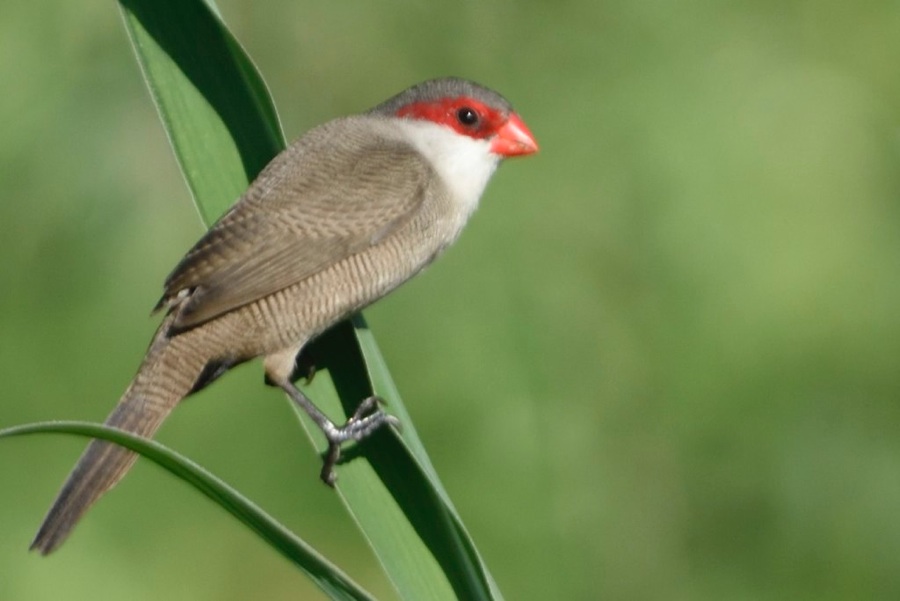
Common Waxbill, Estrilda astrild
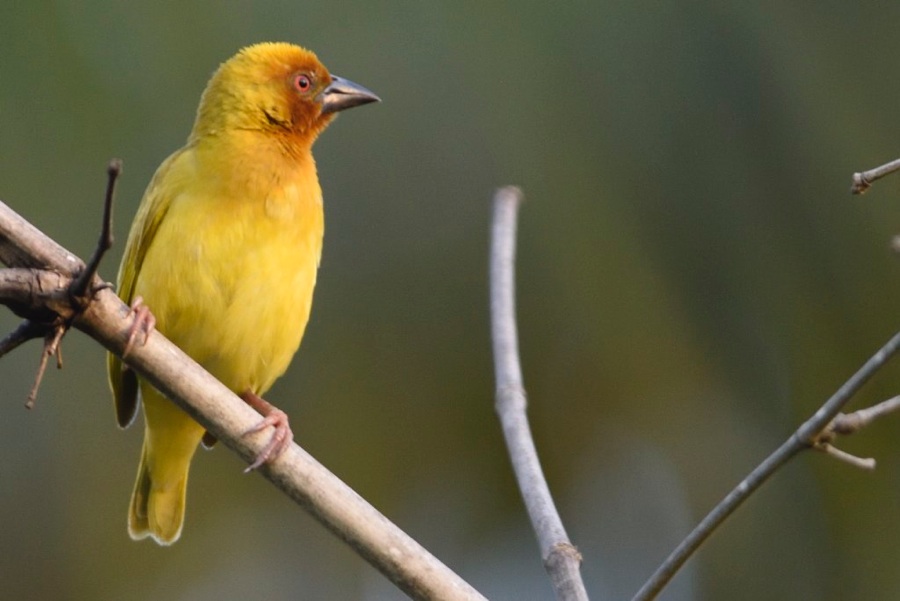
Eastern Golden (Yellow) Weaver, Ploceus subaurus
Day 2, December 27, Morogoro - Hike to Morningside Uluguru Mountains.
Annie had booked a hiking trip for us to an old german building. We did not see many birds on this trip, but managed a few. The going was ok in the beginning, but after a while we got separated. I went with one young guide and Florence and Junior were lagging behind and went with another guide. My guide choose the direct steep route and I thought I was going to die several times on the ascent. I stopped several times and looked for Florence and Junior, but they were not to be seen. I thought maybe the going was to tough for them and that they had decided to go back to the car. When I finally managed to stumble the last few steps up to the German building, my surprise were quite big to see that Florence and Junior were already there. It turned out that they had taken the somewhat longer and less steep route and have had a pleasant walk while I had been struggling with some very heavy gradients. :-). Needless to say we opted for their route on the way down. In terms of birds on the way up, we picked up quite a few Yellow-bellied Waxbills, Scarlet-chested Sunbirds and Southern Citrils. On the way down, we saw a very confiding Olive Sunbird, African Stonechat and some Mosque Swallows collecting nest materials. Later on we picked up our first lifer of the trip: Bertram´s Weaver. We had good view of both the male and the female while they were taking a bath in a stream. They were joined by a Yellow-fronted Canary and a Garden Warbler (African photo lifer for me) in the stream. We soon came to our car and returned to Simbawenni. In the afternoon, I walked a little in the garden and got some decent shots of the Collared Palm-Thrush and also of a pair of Cut-throat Finches
Some pictures from day 2
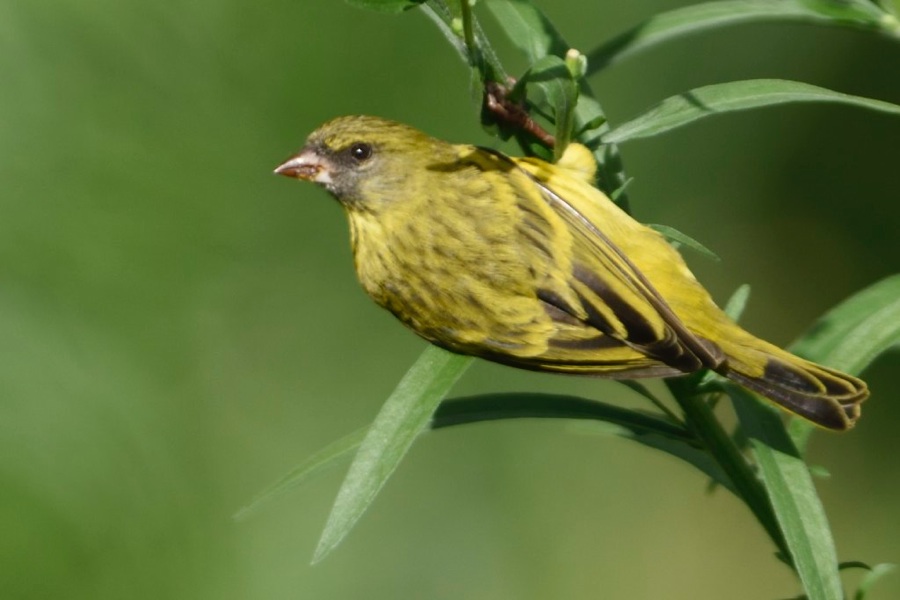
Southern Citril, Chritagra hyposticta
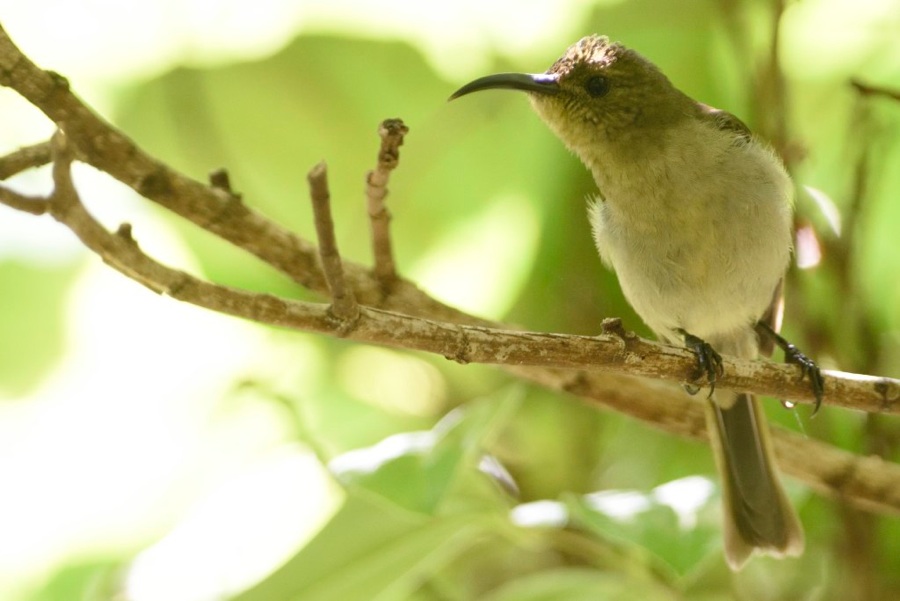
Olive Sunbird, Cyanomitra olivacea
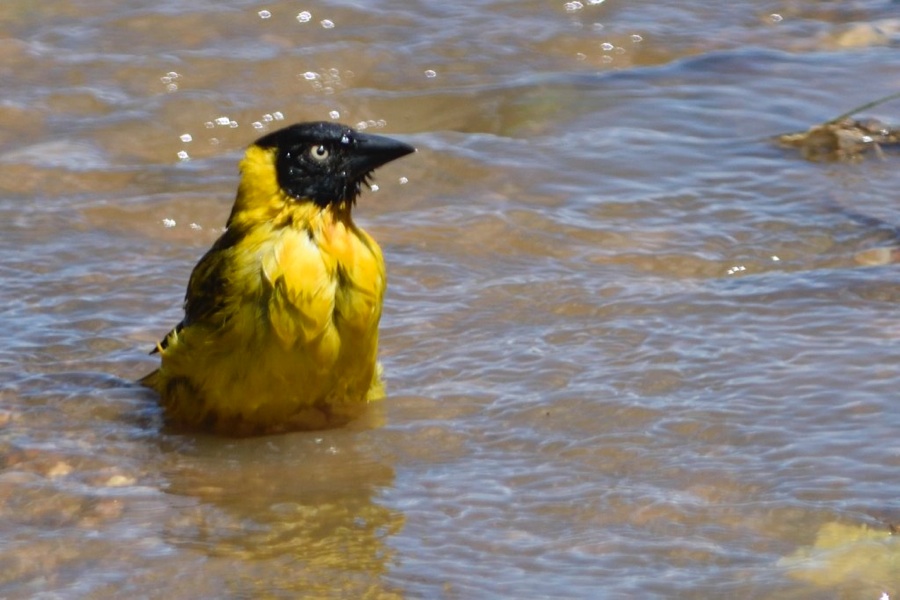
Bertram´s Weaver, Ploceus bertrandi - Female, Lifer
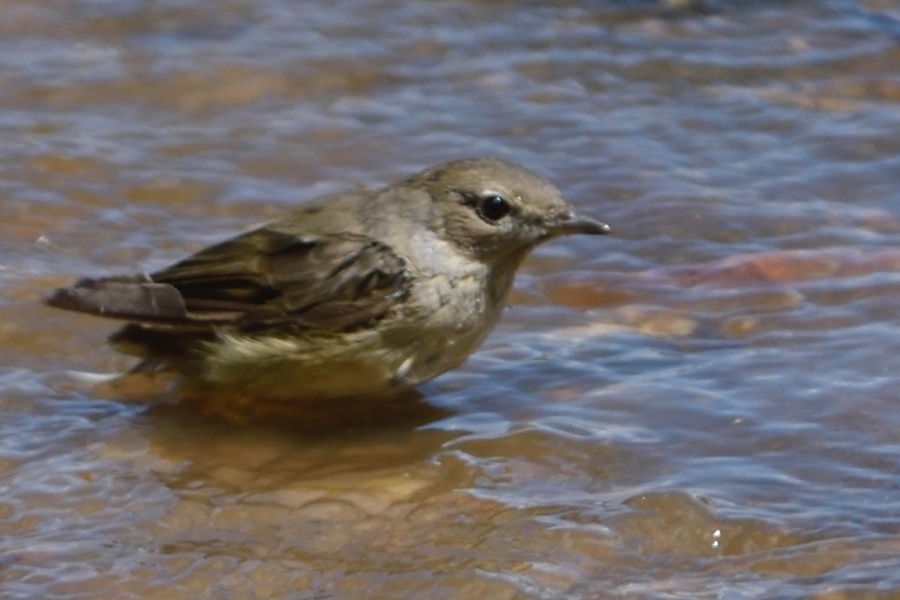
Garden Warbler, Sylvia borin - African Photographic Lifer
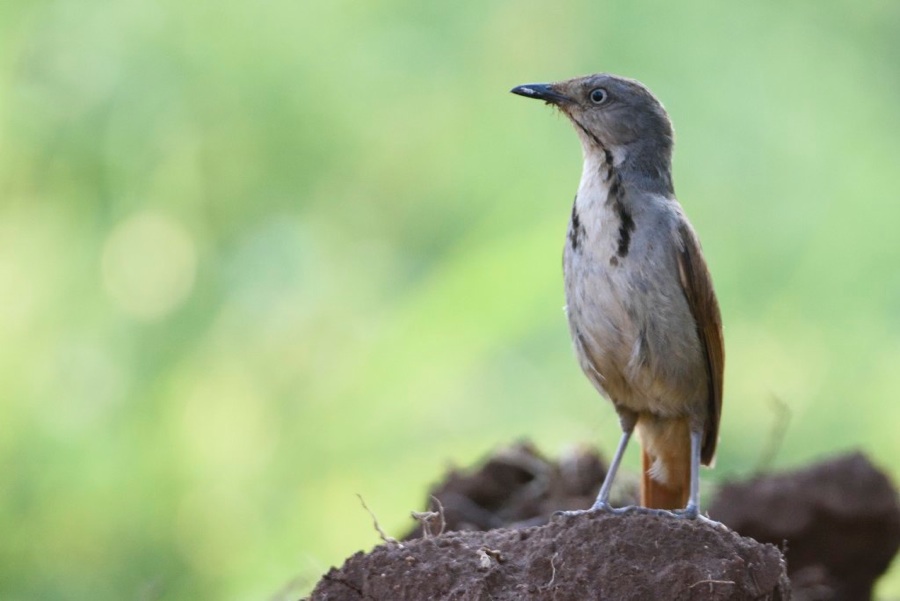
Collared Palm-Thrush, Cichladusa arquata
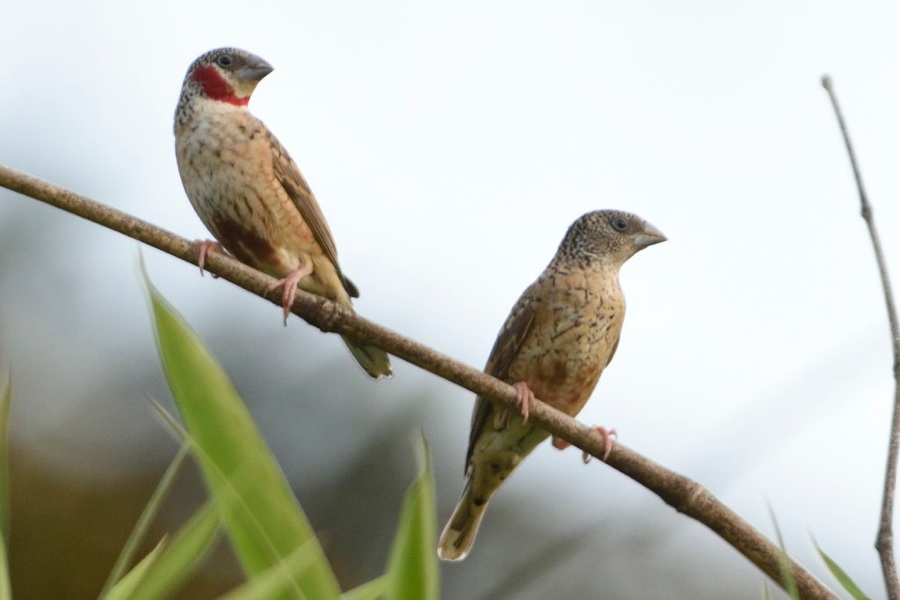
Cut-throat Finch, Amadina fasciata
Day 3, December 28, Morogoro - Uluguru Mountains.
Today, we had very high expectations since we were going up to the Uluguru mountians to look for 4 special birds. Annie had again booked us with the Chilunga Cultural tourism programme. To her credit, she was unsure if the outfit was any good, but the guy had said that he knew his birds. All the gear did not fit into our little RAW 4, so the first surprise was that we had to rent an old Landi to get up to the mountains. We drove for quite a while to the little town of Kinole. We restocked there and continued up to a small mission station right at the forest edge. We were relaxing for a little while and I spotted a Mountain Buzzard high up in the hillside. The guide told us we should enter the forest at 3PM. It turned out that the guide had only been there once before so he did not give us any information on what to expect. He had to bring a local guide, the driver wanted to come + what I believe was a ranger. All in all 4 men + the 3 of us. To my great annoyance, I noticed that our “guide” did not even have binoculars. I was quite perplexed when they started to walk downhill. I tried to protest and said that the forest is there where we came from, but they told us we had to walk down and around to get to the forest. A few hundred meters from camp, we found a tree with a few birds: Klaas´s Cuckoo, Southern Citril and Uluguru Double-collared Sunbird. The next bird we saw was a Tawny-flanked Prinia. I understood what a bad shape we were in when I asked the “guide” to ID the bird for me. Needless to say, he did not have a clue. I felt really bad about this trip and wanted to go back. I did not have a clue how long the walk to the forest would take, but it was now already 3:30 in the afternoon. At least after about 1 km going down we finally started the ascent towards the forest. We could not see any forest, only cultivated fields. Again, I told the “guide” that there was a perfectly good forest just behind the mission station. This caused some confusion and the “guide” had to confer with the “ranger” who told us that there were no paths in from there. So we started a very steep ascent through cultivated fields that I could see no ends on. We reached one summit and I asked how much further since I could still not see any forest. They said just over there. We walked on until I finally could spot a forest in the distance and then I really wanted to return. The mood was getting very bad, but Florence suggested we should continue. They pointed to a tree in the distance and said that the forest started there. I could not see any forest, but gave in again. Another thing that really got me mad was that the 4 men were babbling all the time and any chance we had to see any avian friends were instantly killed by these human babblers. I tried to hush them and in the end had to yell “keep your f... mouths shot”. That helped for a little while. I was now getting seriously exhausted and to cut a long story short, we finally arrived at the fringes of the forest at around 5 PM. I said: Ok, so we used 2 hours to get up here, hence it will take us 2 hours to get back to camp. It gets dark at 7, so when are we supposed to do any birding? Yes, we were at the forest fringe, but the forest gradient were very steep. I know the birds we were looking for were not easy to find. When you are so tired that you cannot even lift your binoculars and you have maximum 15 minutes to bird what do you do? Florence followed the “guide” for a few minutes into the forest while I turned around and started on the home stretch. It did not take long before a couple of the “babblers” caught up with me. I tried again to make them shut up to no avail. I yelled as loud as I could for them to shut the f.... up and it finally worked. They stayed a respectable 50 m behind me from then on. We finally stumbled in to camp at around 7PM. We saw a Livingstone´s Turaco, some White-necked Ravens, Yellow Bishop and a couple of Silvery-cheeked Hornbills. There was a guy at the mission that asked me how the trip had been and I said it was a total catastrophe. I asked him about the forest behind the mission station and he confirmed there were paths there. Needless to say I was quite mad. I had an African shower (a bucket with cold water) and we got some food and then luckily for me I had brought a few beers and a bottle of Whiskey. I can only blame myself for not doing a quality check of the guide, but what moron can arrange something like that? We should have just done some birding around the mission in the afternoon and of course very early the morning after, we should have walked up to the forest. If we had started at 06:00, we would have been in the forest at 08:00. We could then have rested and birded up there for 2 - 3 hours and could have returned to camp in the early afternoon.
I should have posted pictures of Loveridge´s Sunbird, Uluguru Bush-Shrike and Uluguru Mountain Greenbul here, but that has to wait until next time when I will plan my trip a little better.
Day 4, December 29, Uluguru Mountains - Morogoro
After a night in the tent and the fiasco of the day before, I did not feel like going back up to the forest. We packed the camp and went back to Simbawenni. It was very hot so we went to the swimming pool at the Morogoro hotel and spent some time there. In the afternoon I did a little bit of birding in the garden of Simbawenni, but nothing new popped up.
Day 5, December 30, Morogoro - Iringa - Kizolansa
We had a long drive ahead of us today. We picked up our guide Elia just before Iringa and continued to the Old Farm in Kizolansa (50 KM south of Iringa). We had lunch and went birding with Elia. We saw a few birds including Red-headed Weaver and Black-collared Barbet before we found Pinto´s Double-collared Sunbird - Lifer. This is a Sunbird recently split from Miombo Double-collared Sunbird.
Some pictures from Day 5
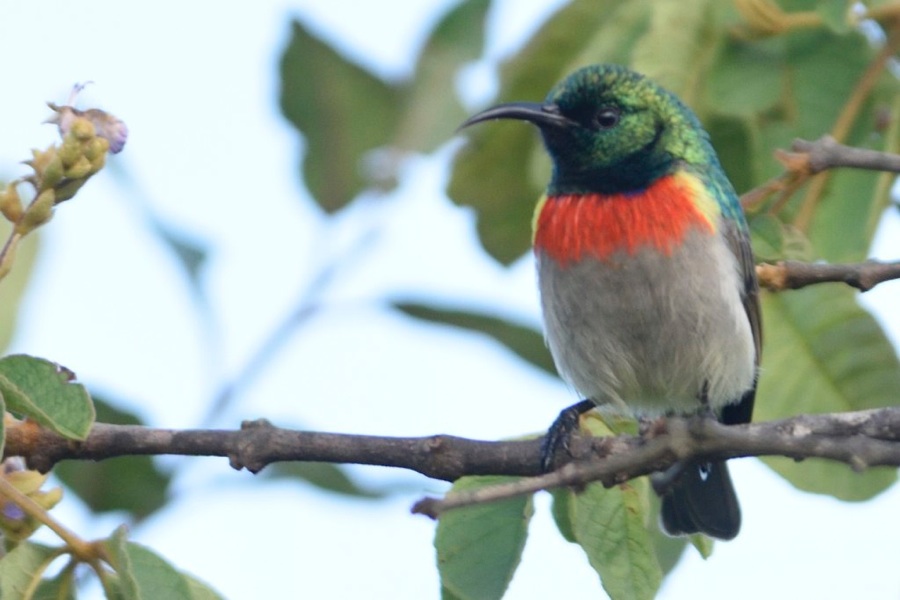
Pinto´s Double-collared Sunbird, Cinnyris pintoi - Lifer
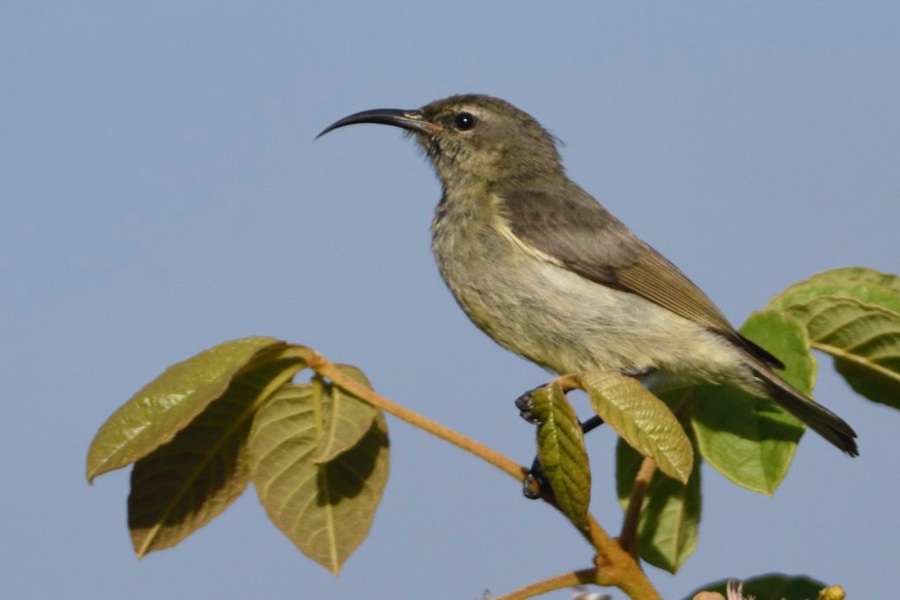
Day 6, December 31, Kizolansa
We met up with Elia quite early this morning. We were to bird the area around the lodge. The light was not really good so it was quiet in the early morning. We found Common Waxbill, Grey Penduline-Tit, Purple-crested Turaco and then finally another lifer: Fulleborn´s Longclaw. On the way back to camp we saw a Tree Pipit. I birded a little in the garden before lunch and picked up White-eyed Slaty Flycatcher, White-browed Robin-Chat and Pin-tailed Whydah. Elia showed up and heard a Brown-headed Apalis calling nearby. I played the sound a little and we had ourselves a new lifer. Elia and I walked a little in the garden before lunch, and only picked up a Tree Pipit. Sitting in the restaurant waiting for lunch, I picked up a Klaas´s Cuckoo. After lunch, Florence decided to stay at the lodge with Junior. Elia and I went for a walk. It was very quiet for a while. Then we had a very heavy rain shower. After the rain, we quickly picked up another pair of Fulleborn´s Longclaws. Then two quick lifers: Stripe-breasted Seed-eater and Long-tailed Cisticola. I had a Purple-crested Turaco posing for me in very bad light, then a Trilling Cisticola in very bad light. The last bird I got a picture of on December 31 was a flock of Abyssinian White-eyes. We had rain and cloudy conditions all day so the light were terrible. Unfortunately we had this kind of weather throughout our trip, so excuse me for the bad light on many of the pictures. The day was not too bad with 4 lifers.
We had a nice meal at the farm and we were all so tired that we were in bed before 10PM on New years eve :-)
Some pictures from Day 6
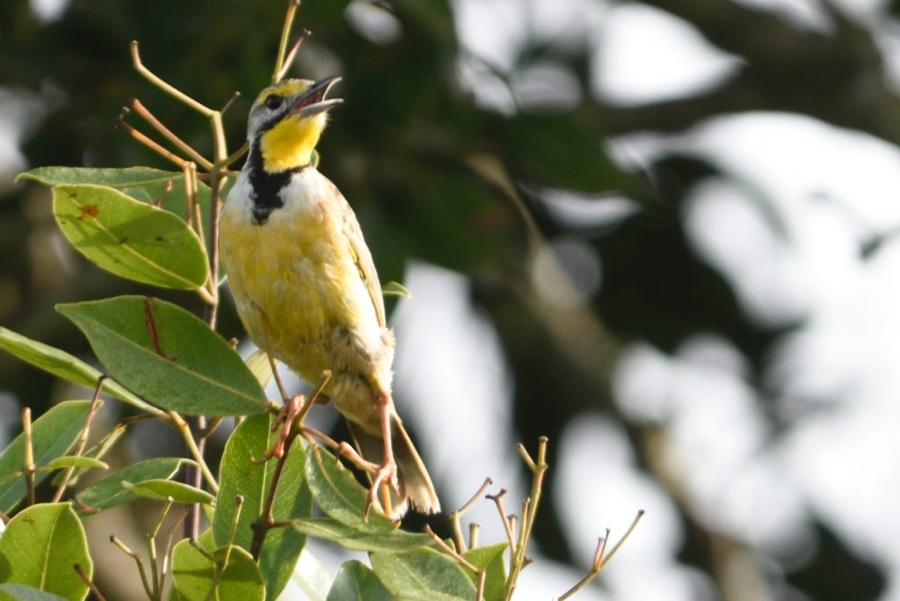
Fulleborn´s Longclaw, Macronyx fuelleborni - Lifer
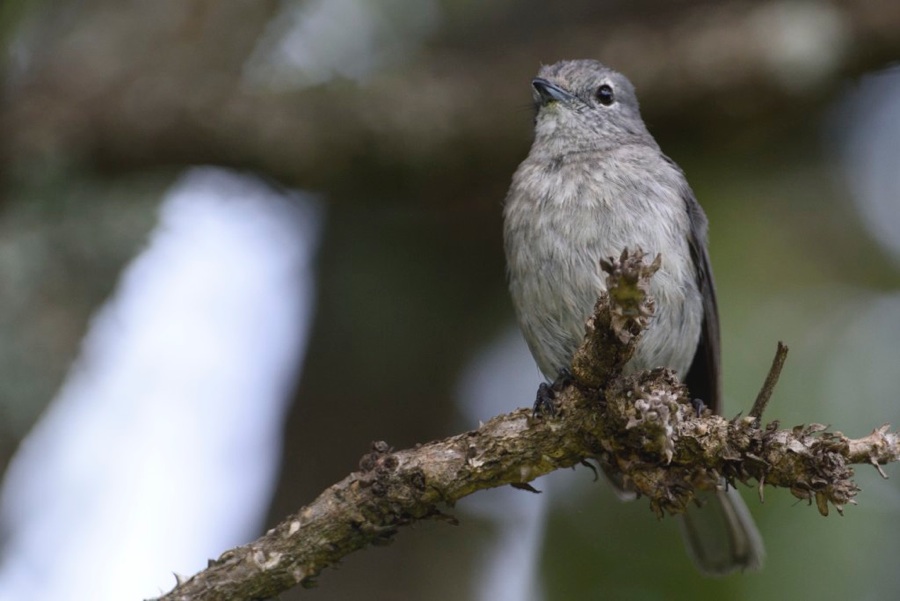
White-eyed Slaty Flycatcher, Dioptrornis brunneus
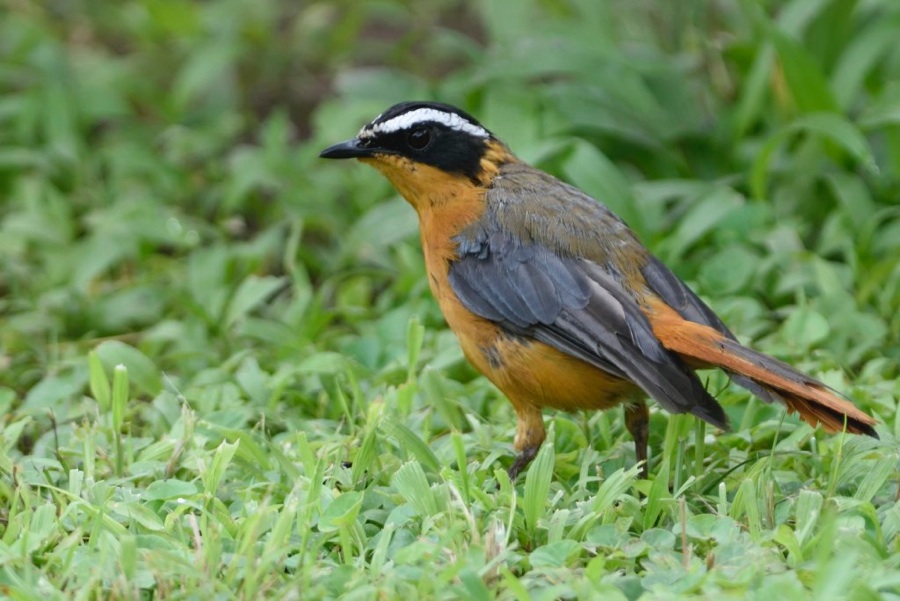
White-browed Robin-Chat, Cossypha heuglini
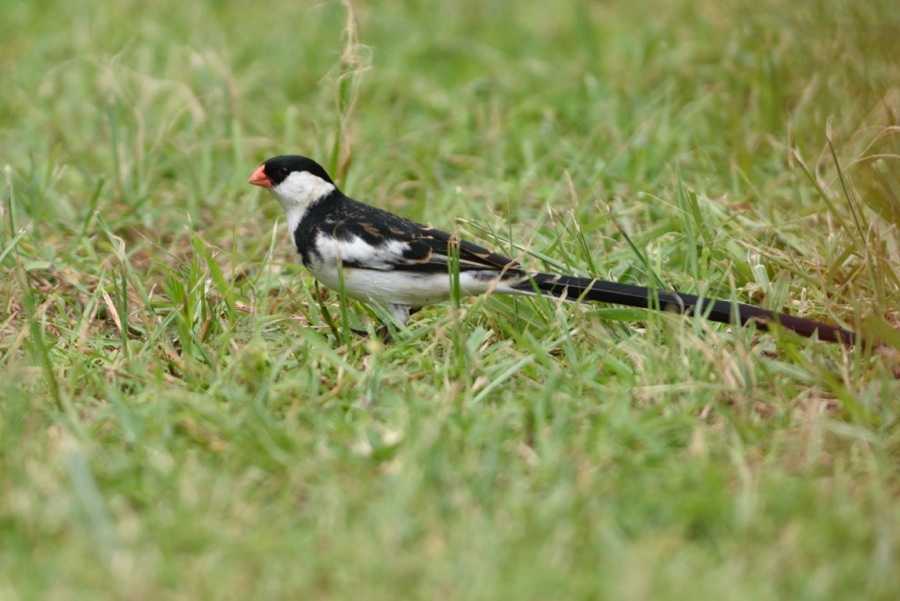
Pin-tailed Whydah, Vidua macroura
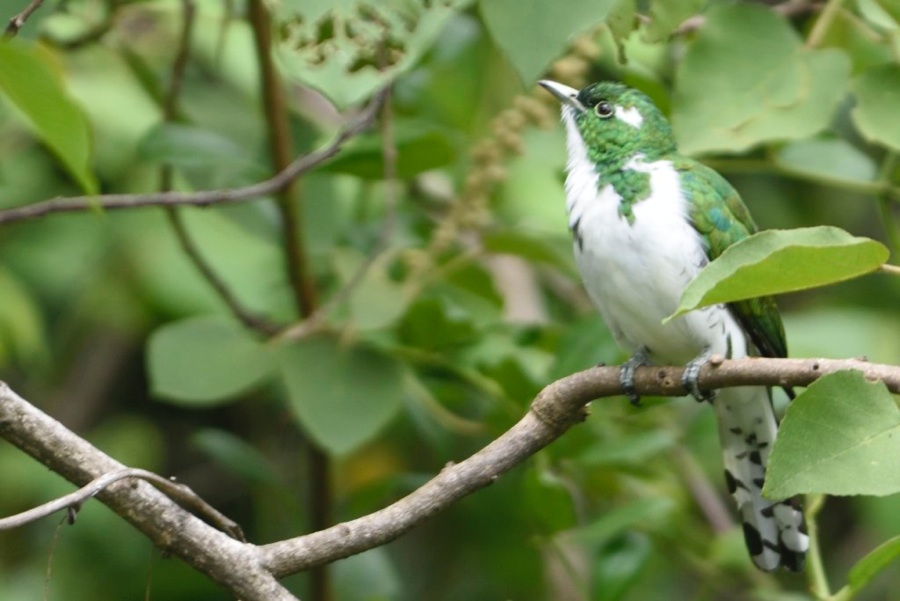
Klaas´s Cuckoo, Chrysococcyx klaas
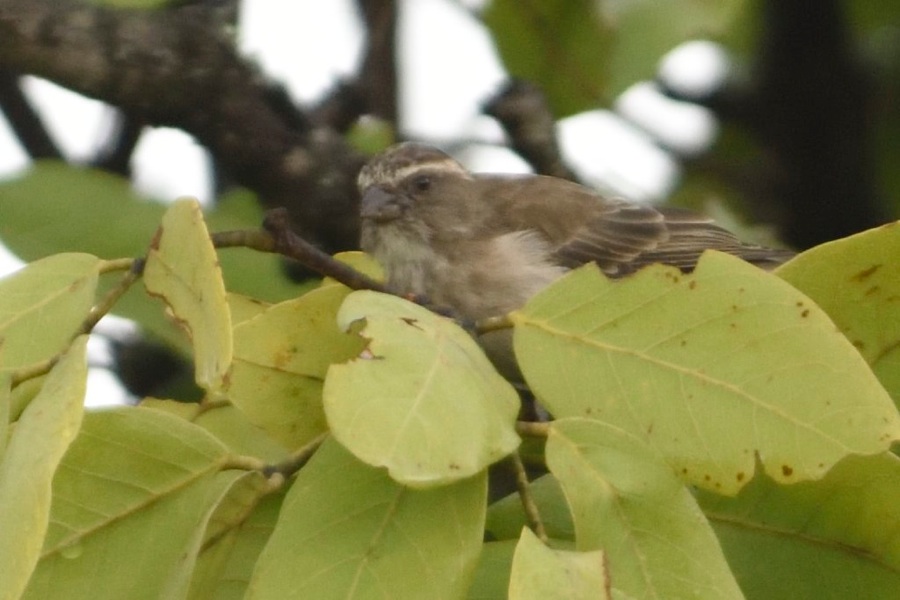
Reichard´s (Stripe-breasted) Seed-eater, Crithagra reichardi - Lifer
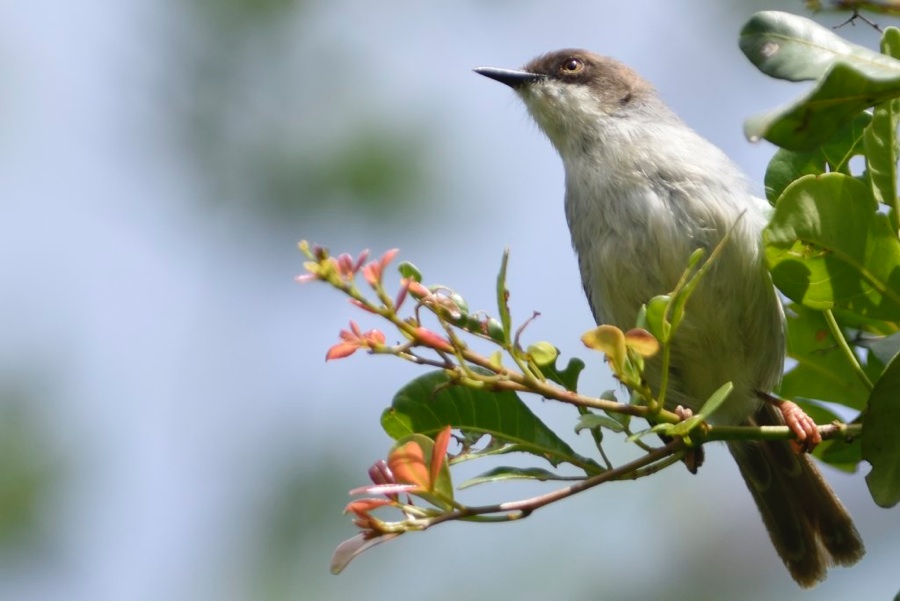
Brown-headed Apalis, Apalis alticola - Lifer
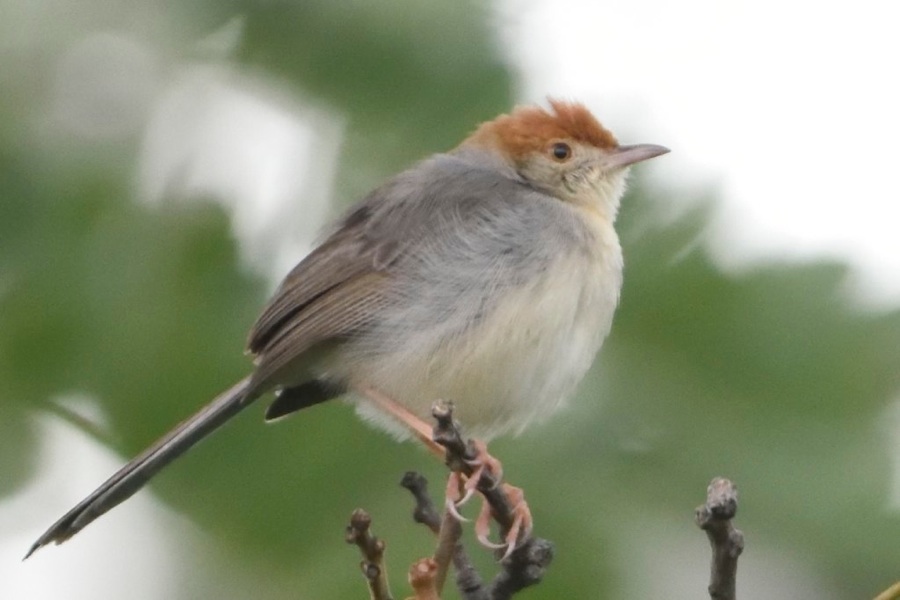
Long-tailed (Tabora) Cisticola, Cisticola angusticauda - Lifer
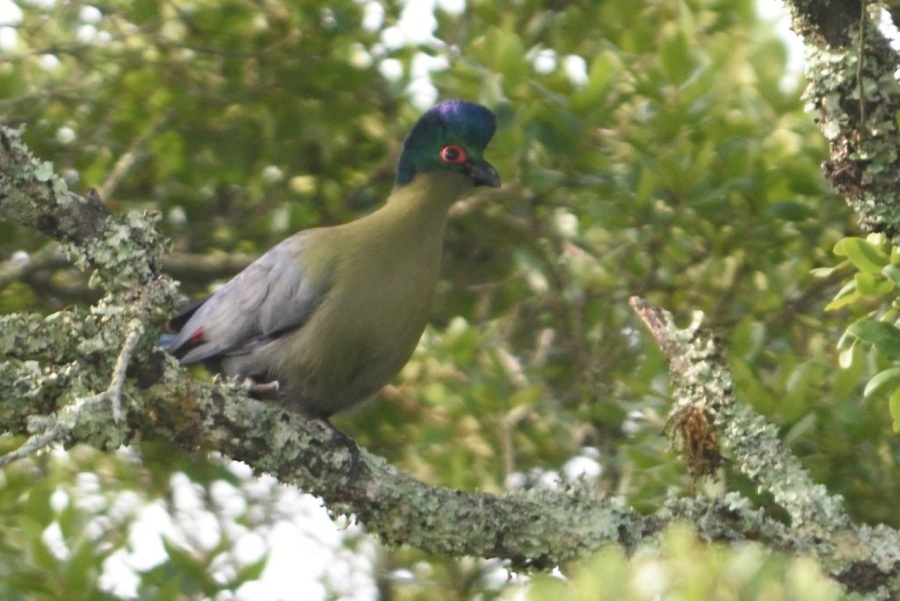
Purple-crested Turaco, Tauraco porphyreolopha
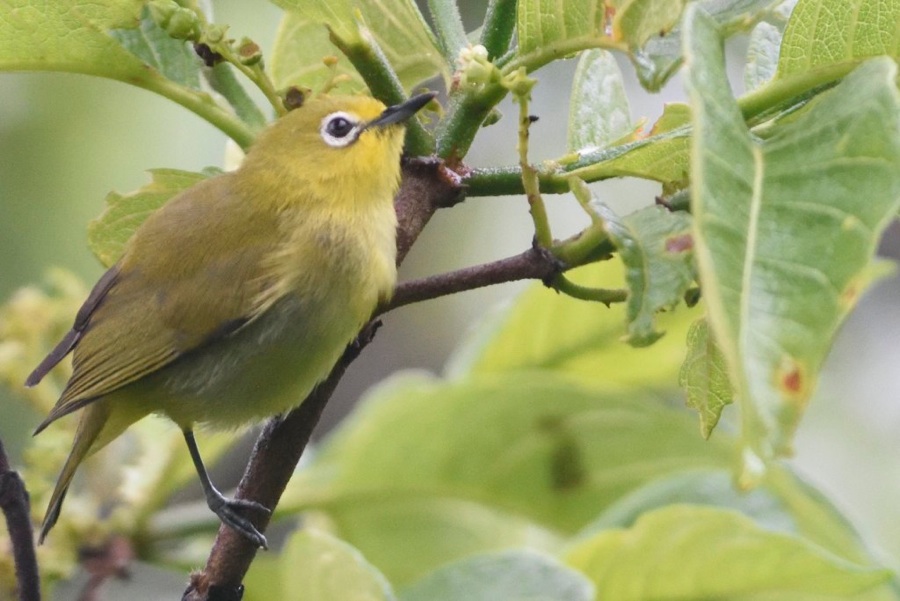
Abyssinian White-eye, Zosterops abyssinicus
Day 7, January 1, Kizolansa - Mufindi
Florence stayed home with Junior this morning so Elia and I had an early start. We found quickly Tree Pipit, Fan-tailed Grassbird (Broad-tailed Warbler), Garden and Willow Warbler and Trilling Cisticola. We walked on for quite a while and then Elia thought he heard Black-lored Cisticola far away. We walked on and after quite a bit of walking and searching, we finally located a pair of Black-lored Cisticolas - Lifer. I got pictures, but very bad light. I caught up with the specie again in Mufindi and will post a picture from there. We were quite far from camp now and started rushing back. I had to stop for a very confiding Fan-tailed Grassbird though. When I came back to camp I saw that a Red-headed Weaver was very upset at his own reflection in the side mirror of the car. I called out to Florence to get a picture. She said he had been busy chasing himself for more than an hour already.
One picture from Kisolanza Day 7, January 1
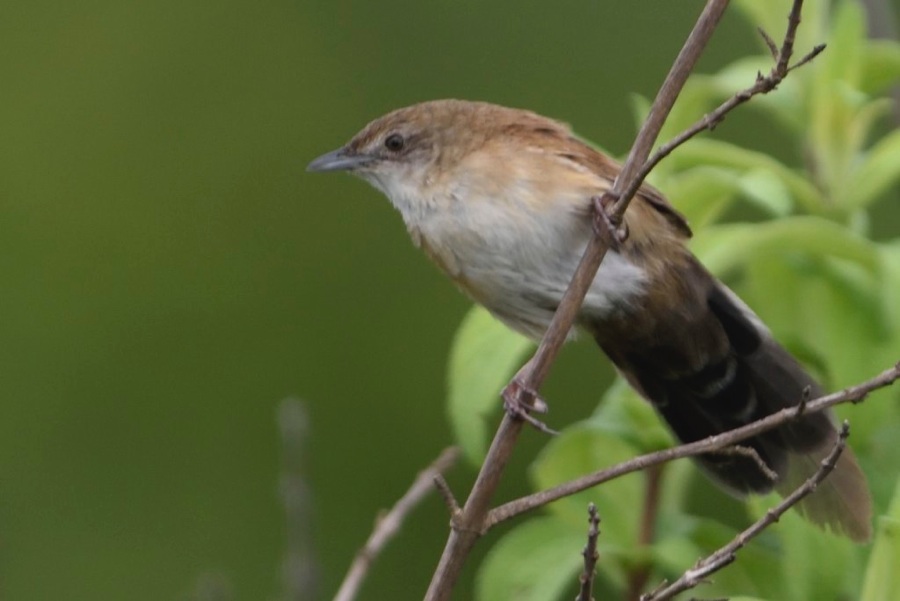
Fan-tailed Grassbird (Broad-tailed Warbler, Schoenicola brevirostris
Day 7, January 1, Kizolansa - Mufindi continued
We had breakfast, packed and were heading for Foxes Farm in Mufindi. The drive was uneventful except the terrible 30Km from the main road and down to the exit to the lodge. The road was very bad. We arrived in camp around lunch time. The rain had followed us there. While waiting for lunch I photographed a African Yellow White-eye from the balcony. A Greater Black-eared Starling was sitting in a tree outside where we had food during lunch. After lunch, we took a walk on the farm. We saw more than 100 Pied Crows in the fields. The Crows were quite a nuisance. We got a tip from Mr. Fox to go to his “enchanted garden”. Once there, we saw a White-starred Robin and then a pair of Dark Batis - lifer. The rain was on and off. We walked towards the ponds in the bottom of the garden. We saw a Fiscal in the distance. When we got closer we were very happy to see that we had a family of Uhehe Fiscals around us. Mom, dad and 2 juveniles - Lifer. The pond held Yellow-billed Ducks, White-backed Duck, Little Grebe, Common Moorhen and Red-knobbed Coots. We saw Moustached and Yellow-rumped Tinkerbirds, Bertram´s Weaver and heard Little Rush Warbler and got my first TZ sighting of African Wattled Lapwing. Now the rain was really pouring down so we had to seek shelter in our cabins. A little later when the rain had stopped, Elia and I went out again. I had a very confiding African Firefinch posing for me. Just by the entrance a very busy Forest Double-collared Sunbird - Lifer were entertaining us for a while. A variable Sunbird kept it with company. We walked a little further and Elia heard Churring Cisticola - Lifer. Unfortunately they did not get close enough for very good pictures. We flushed a pair of Yellow-browed Seed-eaters - Lifer. We tried to find them again, but failed. We returned to the lodge and I continued taking pictures of the Forest Double-collared Sunbird. The light was fading now, so we decided to turn in and head for dinner. A very nice day with a few lifers: Black-lored Cisticola (Kisolanza), Dark Batis, Uhehe Fiscal, Churring Cisticola and Yellow-browed Seed-eater.
Some pictures from Mufindi on Day 7
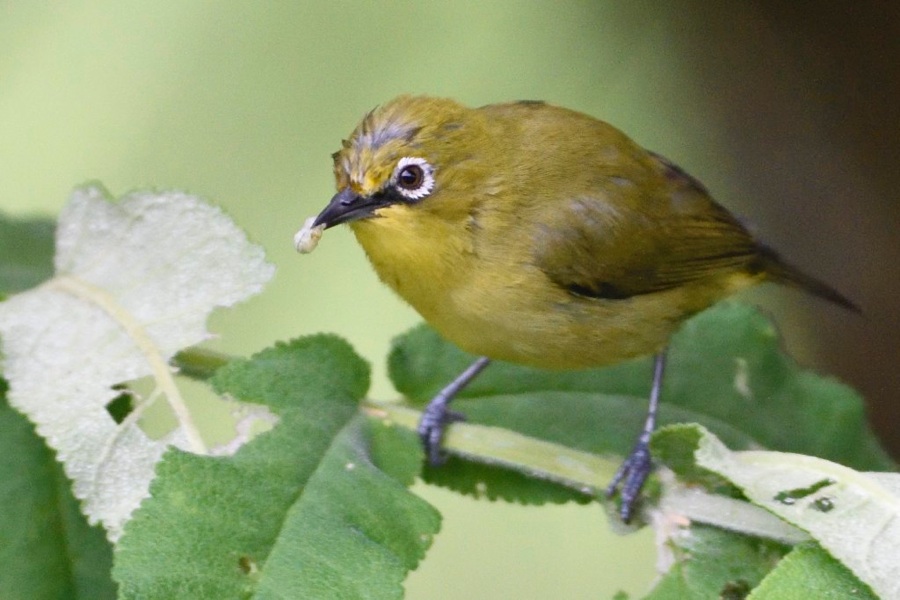
African Yellow White-eye, Zosterops senegalensis
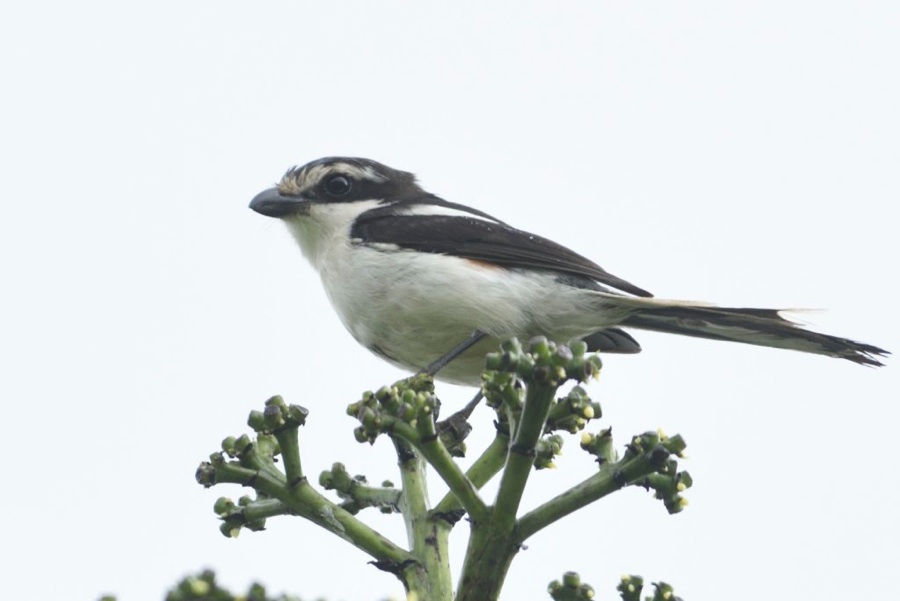
Uhehe Fiscal, Lanius marwitzi - Lifer
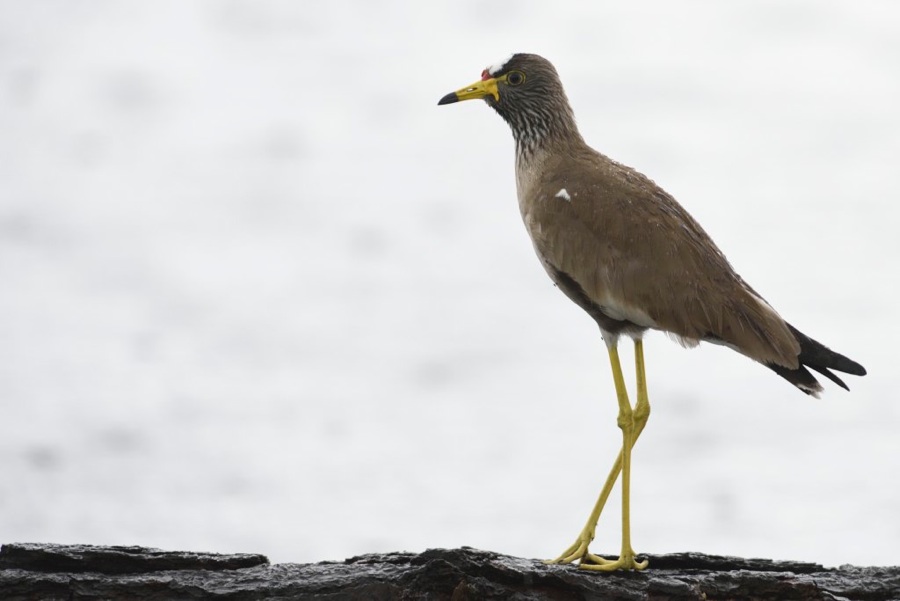
African Wattled Lapwing, Vannelus senegallus
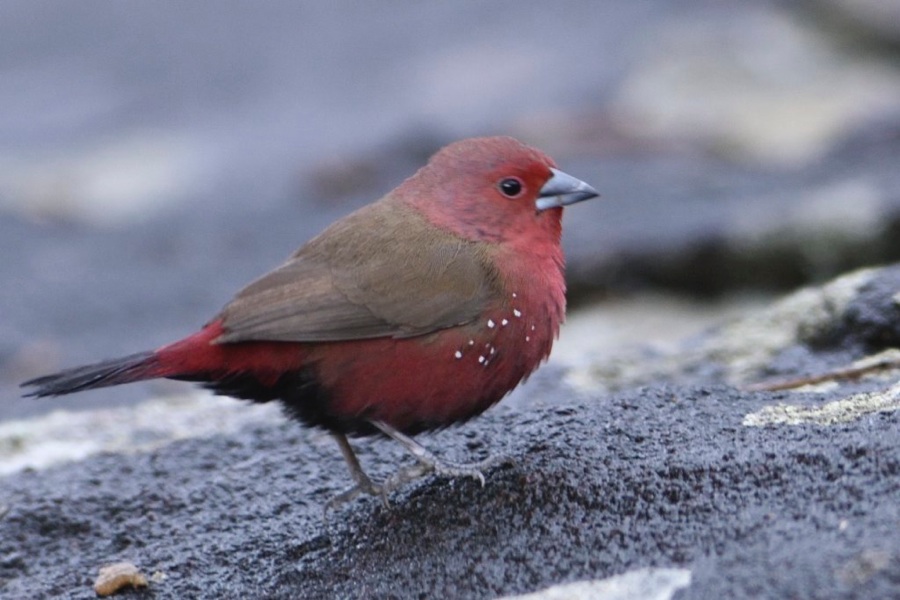
African Firefinch, Lagonosticta rubricata
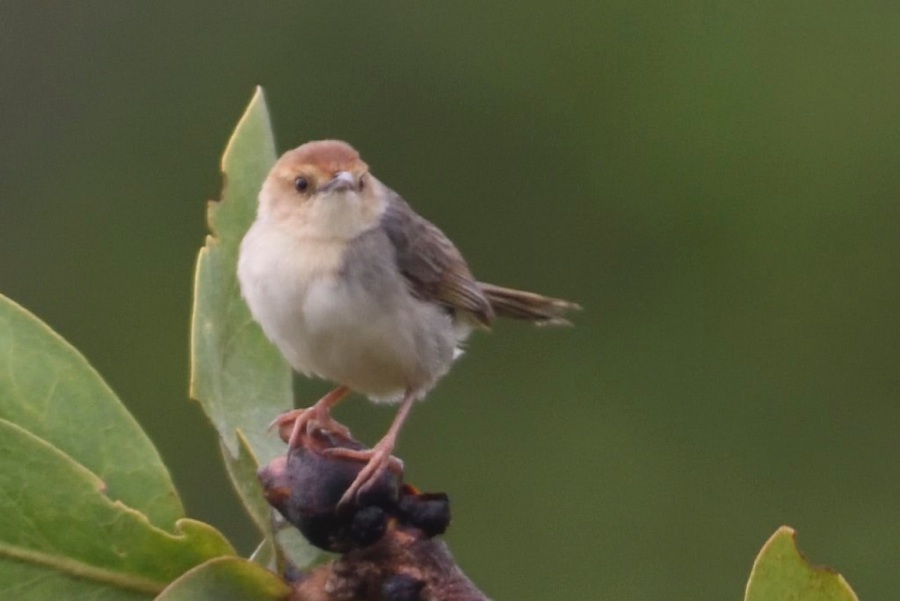
Churring Cisticola, Cisticola njombe - Lifer
Day 8, January 2, Mufindi
We had an early morning start with packed breakfast. We were now heading into the woodland along the tea plantations. Elia had been there before and knew exactly were to go. Birds were singing everywhere, but the forest was very dense. We got a glimse of a Fulleborn´s Boubou. The Olive-flanked Robin-Chat were calling everywhere, but did not want to come out. The Yellow-throated Greenbul - lifer made a quick appearance on top of a tree and I managed to get a very back lit picture. Bar-throated Apalises and Yellow-rumped Tinkerbird were not that shy. Then suddenly the Olive-flanked Robin-Chat were posing on a naked branch. When we lifted the cameras, it was gone in an instant. Around a bend in the road, we found a White-chested Alethe feeding on the road. It was also gone before we managed any decent pictures. This is how it continued through the forest. Birds everywhere, but just short glimpses if they showed themselves at all. Elia told us he had another spot he wanted to check out. We started going there, but stopped on the way to take a closer look at a Starling in top of a tree. This turned out to be a Slender-billed Starling- Lifer. Unfortunately the bird flew when we got close enough for a picture. We found Striped Pipits in the same tree. The new forest patch were very steep and we parked on top and walked slowly down. Elia heard Sharpe´s Akalats, but we could not get them out in the open. Better luck after a few meters with a pair of Iringa Akalats. We got fairly good views of them although they never really came out in the open except when they flew across the road. Neither Florence or me managed to get any decent pictures although Florence´s efforts were much better than mine. We returned to camp for lunch. I continued taking picture of the Forest Double-collared Sunbird before lunch and finally got some good ones.
After lunch we walked a little in the garden. We saw the Bertram´s Weavers and a Moustached Tinkerbird. Elia and I walked on and found a Yellow-browed Seed-eater. We had beautiful views, but it flew off before I got a picture. We located it again, but only got record shots. We walked on and found a Mountain Yellow Warbler (lifer). More Bertram´s Weavers, another Yellow-browed Seed-eater in bad light + a pair of Black-lored Cisticolas. We walked back to camp and found Black-lored Cisticolas again + Brown-headed Apalis. The light was going and another good birding day was over. I got the following lifers: Olive-flanked Robin-Chat (no picture), Yellow-throated Greenbul, Slender-billed Starling (No picture), Iringa Akalat (No picture) and Mountain Yellow Warbler
Some pictures from Mufindi on Day 7
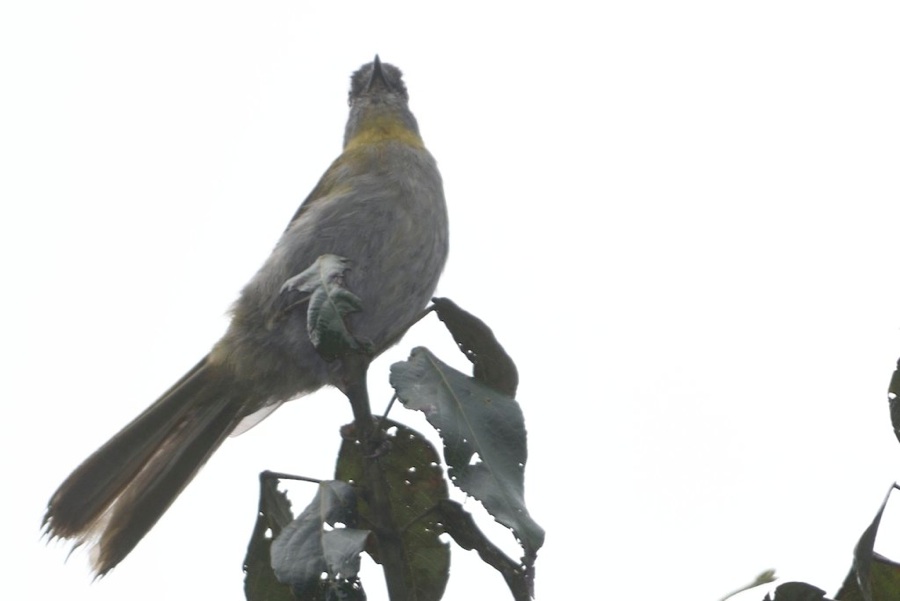
Yellow-throated (Mountain) Greenbul, Arizelocichla chlorigula - Lifer
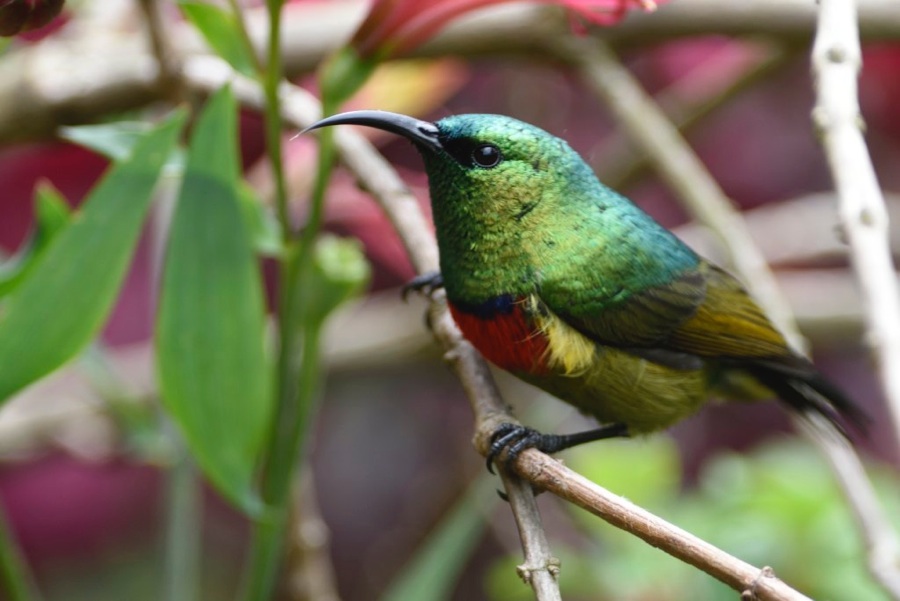
Forest Double-collared Sunbird, Cinnyris fuelleborni - Lifer
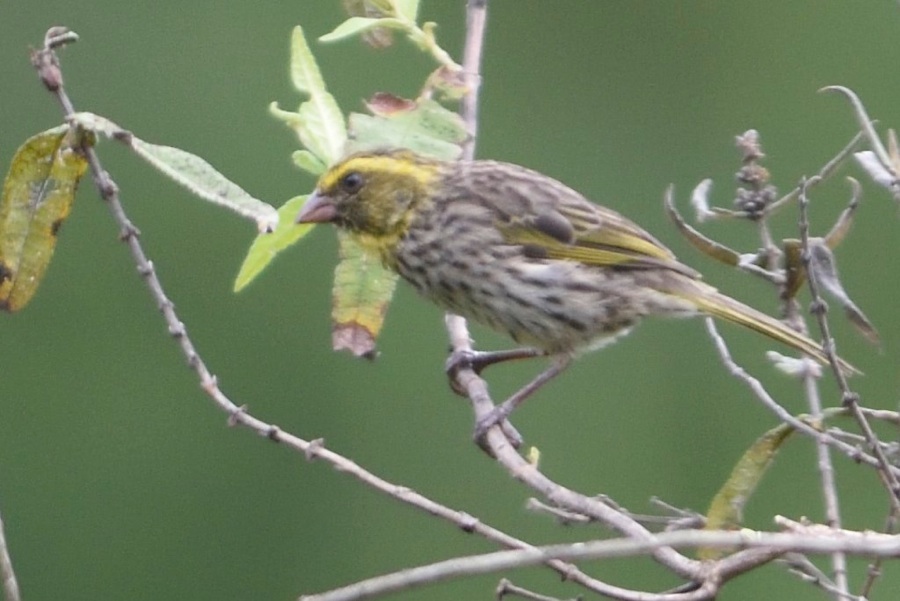
Yellow-browed Seed-eater, Chritagra whytii - Lifer
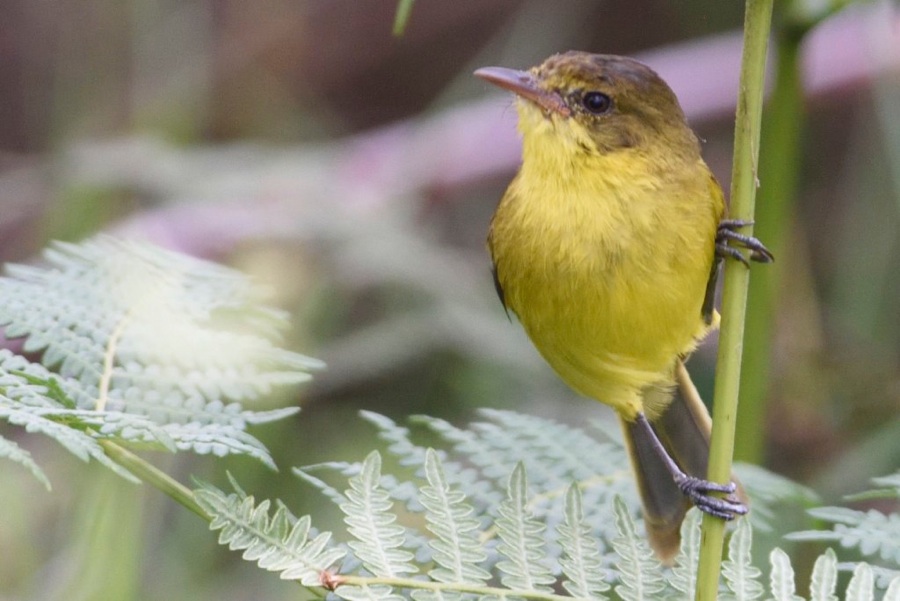
Mountain Yellow Warbler, Iduna similis - Lifer
Day 9, January 3, Mufindi
We had an early morning start with packed breakfast again. We went back to the same Forest patch as the day before. As yesterday, the White-chested Alethe was out on the road and I finally managed to get some half decent pictures of it. The Alethe has been a bogey bird for me. I have seen it twice in Mozambique, but never managed to get a picture. We walked up the hill and we finally connected with some Chapin´s Apalis - Lifer. They are always high in the canopy and very hard to get a decent picture off. But I managed a record shot. Next I found a Eurasian Blackcap. This was an African Lifer for me. Quite common in Norway, but never seen it in Africa. The problem when you walk in dense forest, you have your camera rigged with a flash. When you come to an opening, you forget to reset your camera, so the pictures got heavily overexposed. We heard Spot-throat several times, but I have yet to see this bird. A yellow-rumped Tinkerbird were sitting in the same tree as the Blackcap. We got in the car and headed for the Akalat spot. On the way we found a Steppe Buzzard. We parked on the bottom of the forest and walked all the way to the top without even hearing the Akalats. We took the car to the top of the forest and walked along the forest edge. I finally managed to get a half decent shot of a Dark Batis. We drove on since Elia had a spot for Stout Cisticola, but we could not locate any. We returned to camp. I took some pictures of the resident Variable Sunbird in the garden.
After lunch we went to check up on a Blue Swallow nest. The nest was actually on a wall and not in the ground as in South Africa. No one was home though. We drove on, parked and checked a lot of good habitat looking for the Stout Cisticola, but found only African Pipits and Churring Cisticola. We went back to the forest and found an African Goshawk. We started going back to camp. I stopped because Florence had not yet got the Mountain Yellow Warbler. I asked Elia to take her to the place we found it the day before. I walked a little on my own. I only picked up White-eyed Slaty Flycatcher and quite a few European Bee-eaters. The light was terrible so we did not even try to get any pictures. Florence and Elia walked back to camp so I had to take the car. When I pulled in to the parking lot, I had the Black-lored Cisticolas very close and managed to take some nice pictures.
Some pictures from Mufindi on Day 8
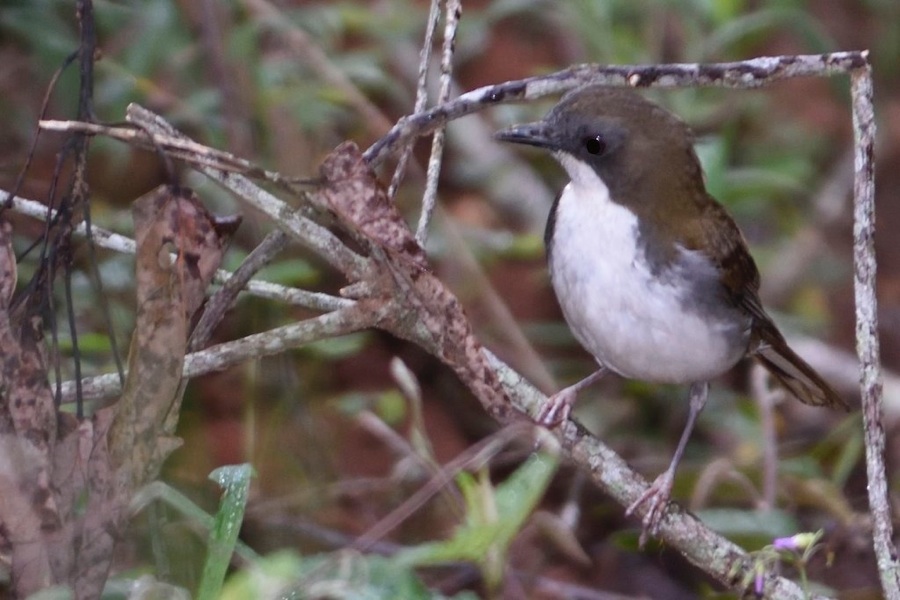
White-chested Alethe, Pseudalethe choloensis - Photo Lifer
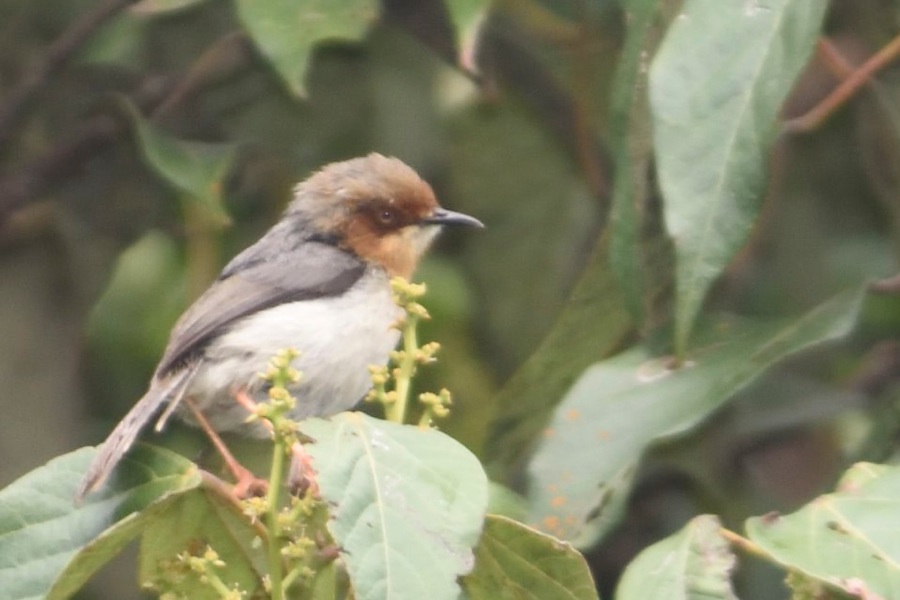
Chapin´s Apalis, Apalis chapani - Lifer
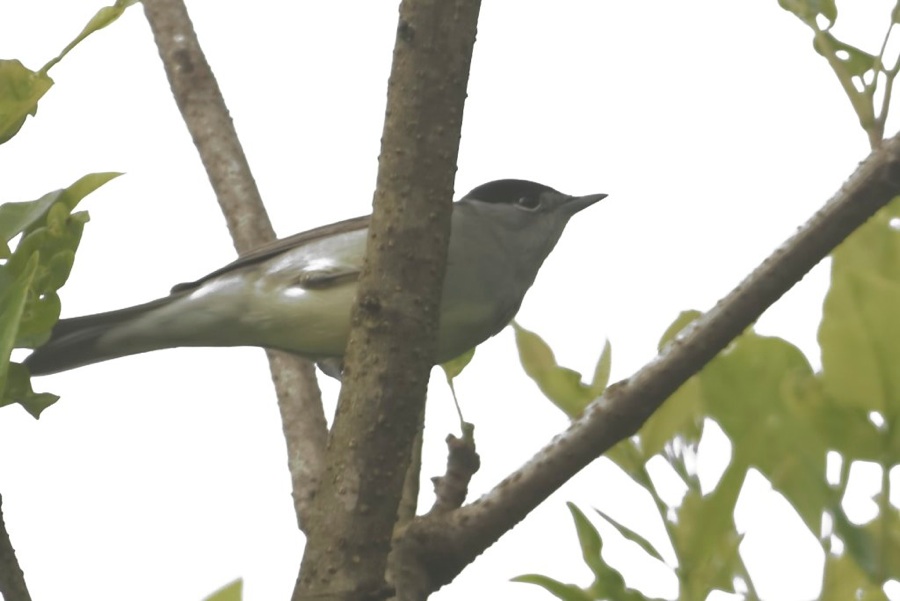
Eurasian Blackcap, Sylvia atricapilla - African Lifer
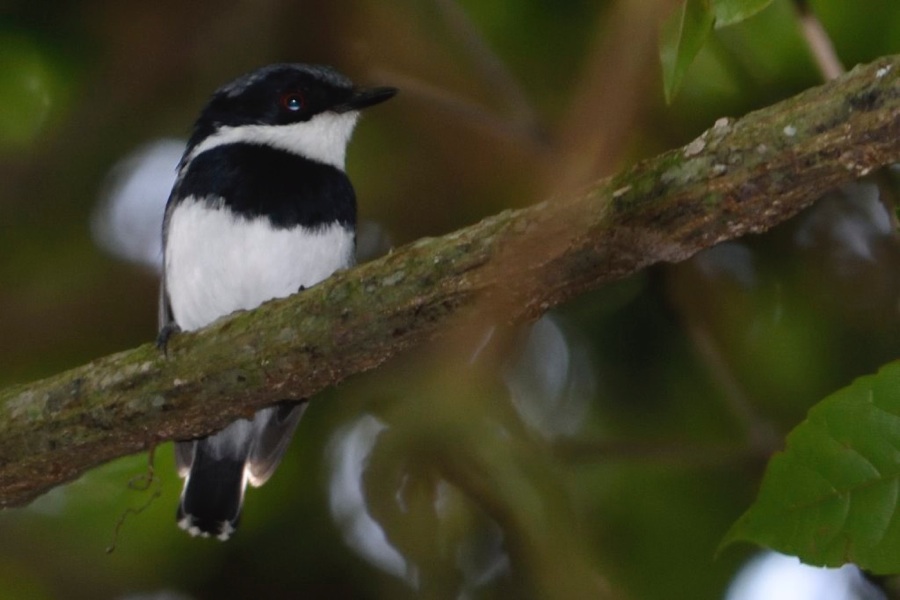
Dark Batis, Batis crypta - Lifer
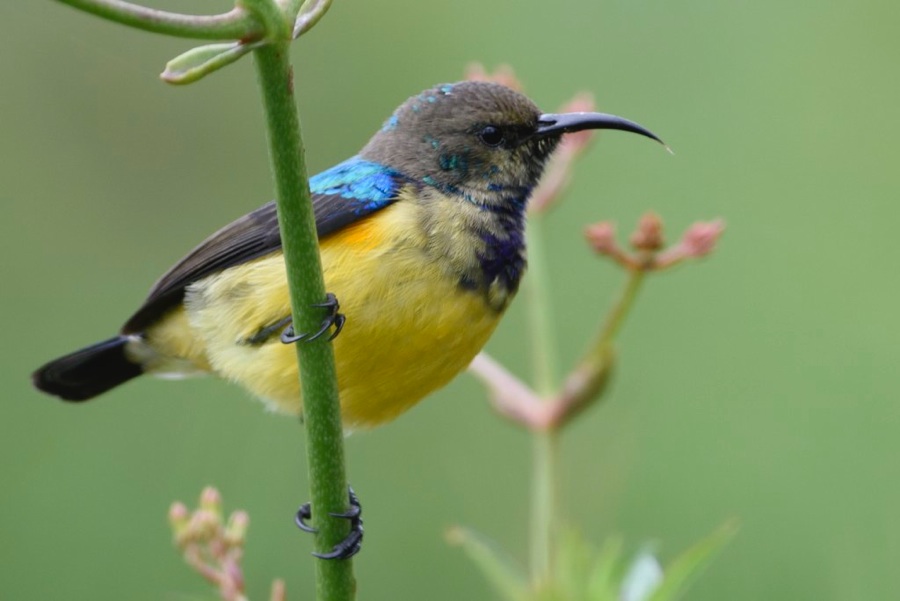
Variable Sunbird, Cinnyris venustus
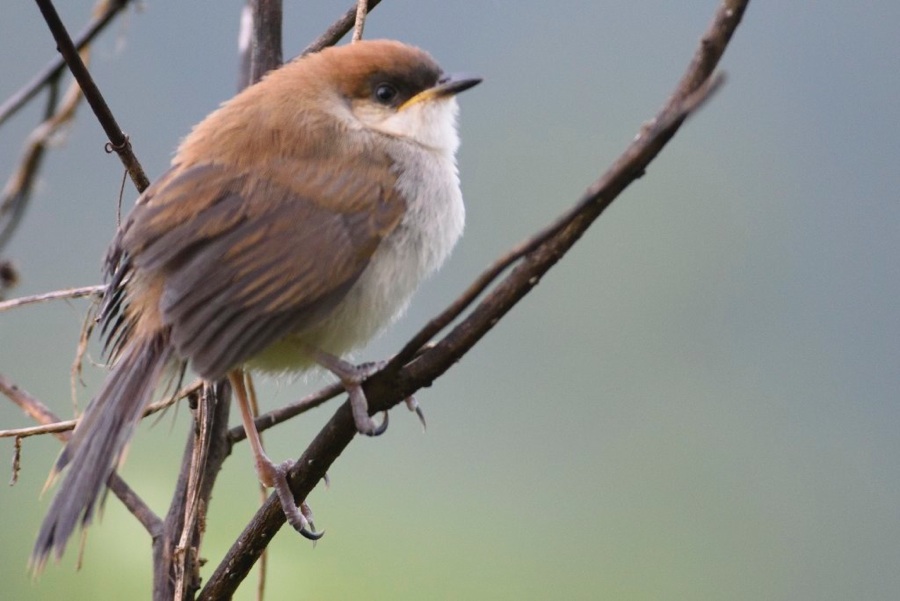
Black-lored Cisticola, Cisticola nigriloris - Lifer
Day 10, January 4, Mufindi - Iringa
Another early start. This was our last morning birding in Mufindi. We wanted to check out another forest patch this day. We went down to were the farm had a trout hatchery and walked a path there. There were quite a few birds and we heard birds like Olive-flanked Robin-Chat, Fuelleborn´s Boubou, Spot-throat, Dark Batis and Yellow-throated Greenbul. We got glimpses, but no pictures of a few of them. Florence was lagging behind and soon we lost contact with her. I had very nice view of a Livingstone Turaco and we heard a Barred Long-tailed Cuckoo, but no pictures. Elia and I walked quite far and came to a second pond. Then it started raining and we had Florence´s rain jacket with us. We walked quickly to find her, but it took a long time before we hooked up. She had taken quite a few pictures and at one point had been attacked by two birds. She had not gotten any pictures so we are not sure what attacked her. The rain was still pouring down so we returned to the car for breakfast. In more than 3 hours I had not taken a single picture. We finished breakfast and drove back to camp. On the way, we stopped for a Mountain Buzzard. We flushed it before we got close enough for any decent pictures.
We returned to camp, packed and left for Iringa. We arrived in River Valley Camp in time for lunch. After lunch, we finally met Mr. Birding Tanzania, Neil Baker. We had a nice chat and decided to meet up later during the trip. After Neil left, we did a little birding in the garden of the camp, but nothing of interest.
Day 11, January 5, Iringa area
We decided to explore the area around the camp. Florence love Turaco´s and she finally had a Purple-crested Turaco posing nicely. She fired away and was very happy until she found out that her memory card had somehow been dislocated so none of her pictures were stuck on the card. The lady was not happy, so Elia and I kept a low profile for a while. There are supposed to be a Finfoot on the river (I do not have picture), but we could not find it. We saw Grey Olive Greenbuls, quite a few Purple-crested Turacos, but none posing nicely. We came to the neighboring camp and birded for a while in the garden there. We found Black-headed Oriole, Black Cuckooshrike, African Paradise Flycatcher, Hamerkop and a Wahlberg´s Eagle. We stopped and took some picture of the Eagle. We continued birding in the garden and got Golden-backed Weaver and Red-faced Crombec. We continued up a hill and heard a Grey-headed Bush-Shrike. We saw the Shrike and chased it for almost 2 hours until Florence finally managed to get a picture. We returned to camp and I picked up a Jameson´s Firefinch in the garden.
I had promised Florence to visit Iringa town, so we decided to have lunch there. Elia suggested a restaurant and we went there. The first person we saw was Neil Baker. “Per, what the hell are you doing here, you are supposed to be out birding” was how he greeted us. We met his wife Liz and some friends and members of his family. Junior, Florence and I ordered Chicken and chips and it might have been the driest chicken I had ever had. Neil came by our table and invited us to a beer and some birding on his property later in the afternoon.
We went back to camp, picked up Elia and headed towards the Bakers. We parked the car in front of the house and Neil came out and sent us on our way again. He knew I needed White-bellied Tit. He had just talked with David Moyer and he had them in the garden. We drove up to David Moyers house. Talked with his daughter and were allowed to bird on the farm. There were plenty of birds around. We were searching everywhere for the one we needed and it took a lady to find it. Florence always like to walk on her own. I asked her what are you taking picture off and she said: “I think I have the bird”. I walked over and sure enough she had located not only one but three White-bellied Tits (Lifer). We traced the Tits until they disappeared. I had a hard time getting Florence back to the car, but eventually she gave in. She was so happy to see birds everywhere. We stopped for a nicely perched Black Cuckoo. Unfortunately the light was very bad.
We returned to the car and drove back to the Bakers place. This time he did not send us away, but invited us for a well deserved drink. He has lived on the place for roughly 6 months and already have a garden list of more than 150 species! After the beer was finished, Neil suggested we should take a walk. It was a very nice walk, but not too many birds to see. Quite a few Pipits around including a Tree Pipit we got some pictures off. A Flappet Lark was displaying and a few European Bee-eaters were sitting around. We also had a long distance view of a Black-bellied Bustard. Time was running fast and we were already a little late for our dinner in camp, so we said goodbye to Neil and headed for camp. It was also time to say goodbye to Elia. Elia is a fantastic guide that know his forest birds very well. I can highly recommend him. As mentioned, we were a little late for dinner. We found there was only one chicken leg left. We had to settle for luke warm Lasagne.
Some pictures from day 11 around Iringa.
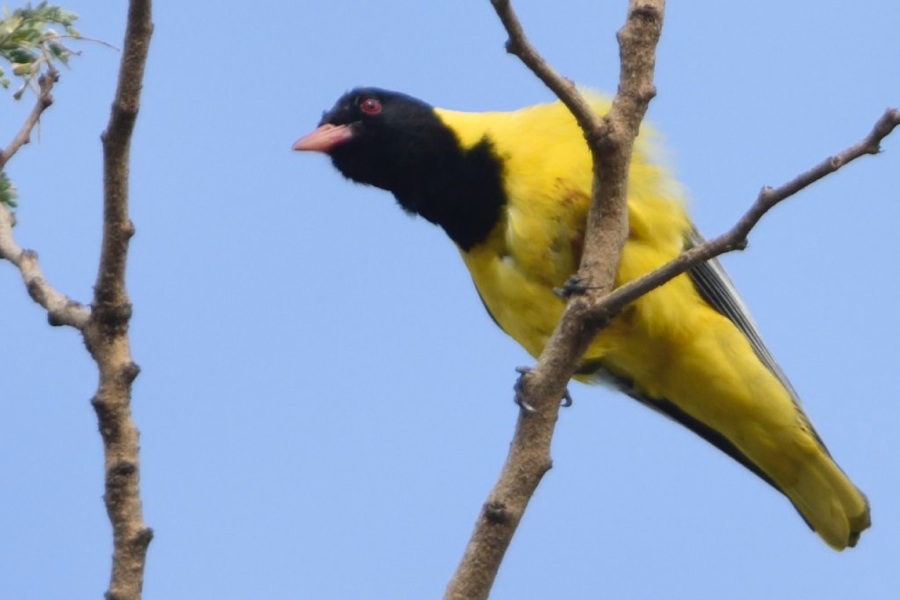
Black-lheaded Oriole, Oriolus larvatus
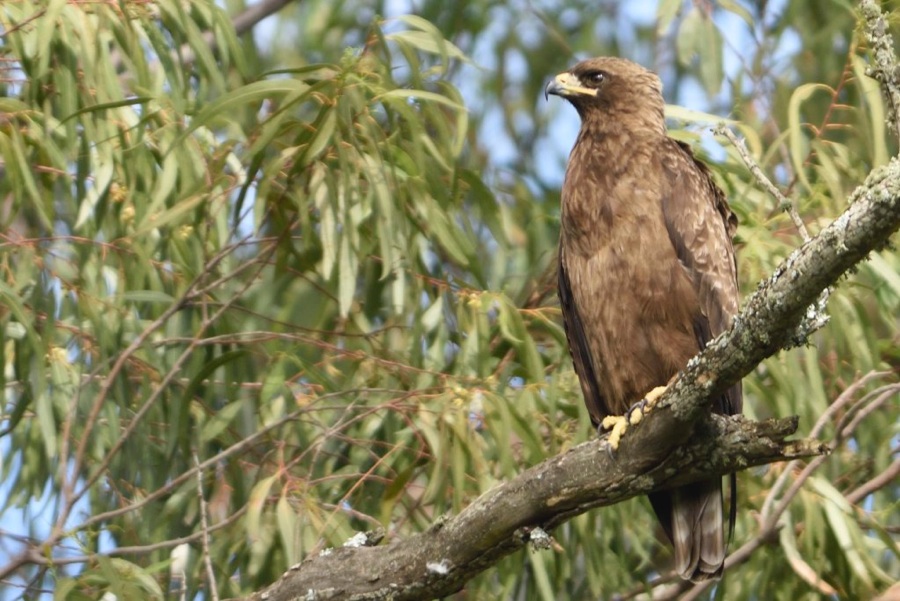
Wahlberg ´s Eagle, Hieraaetus wahlbergi
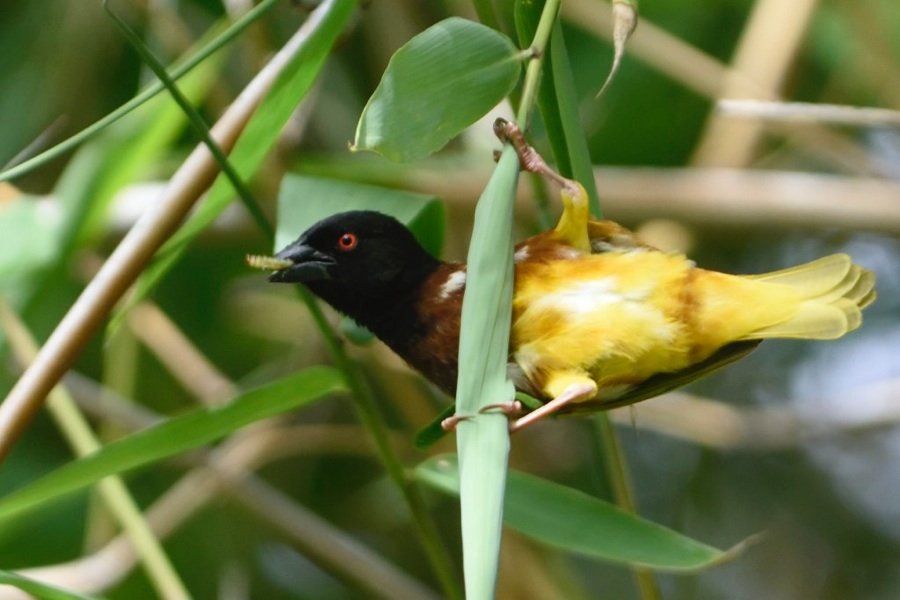
Golden-backed Weaver, Ploteus jacksoni
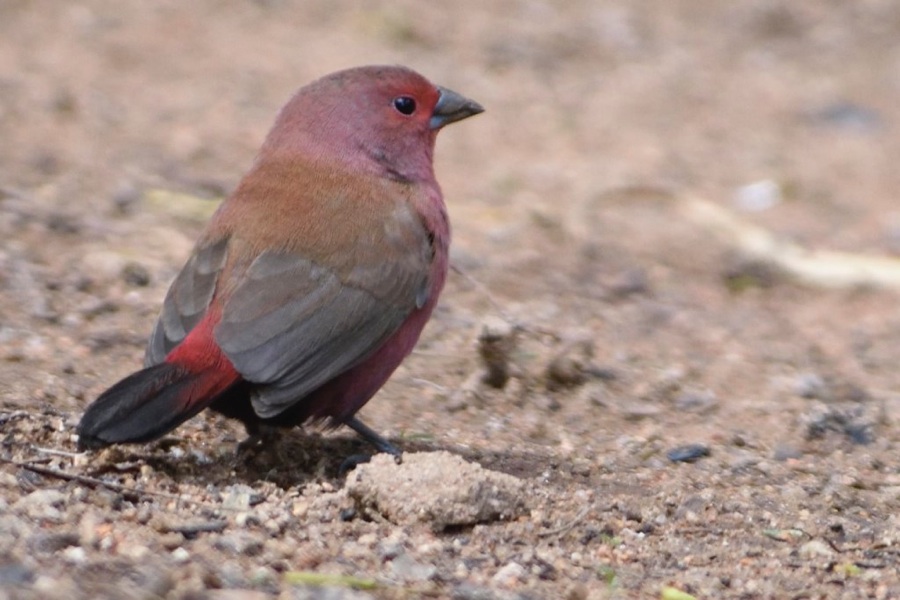
Jameson´s Firefinch, Lagonosticta rhodopareia
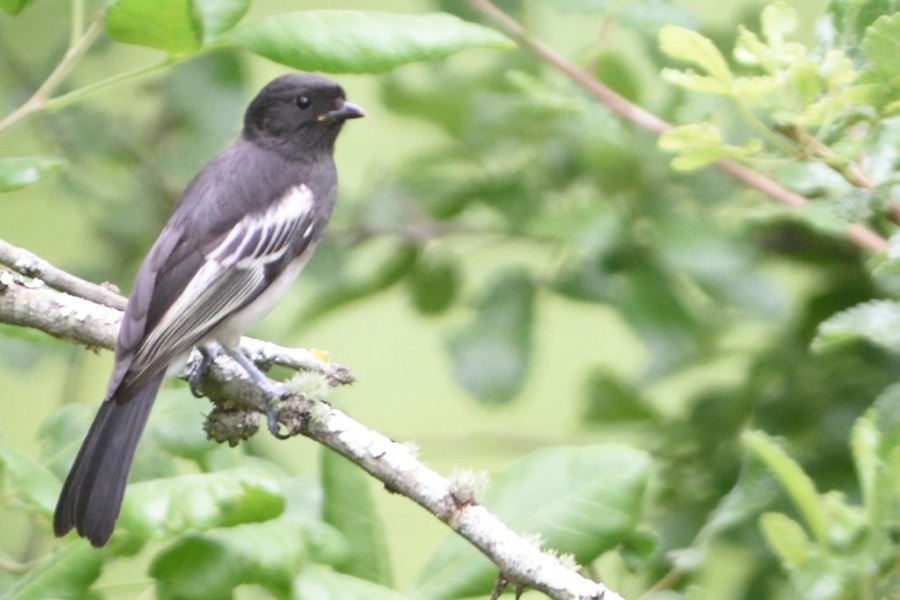
White-bellied Tit, Parus albiventris - Lifer
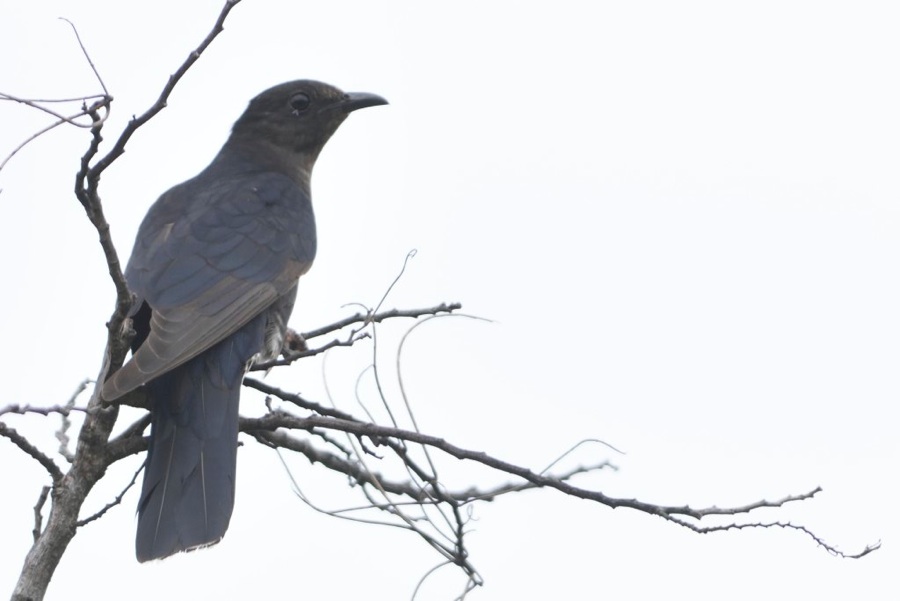
Black Cuckoo, Cuculus clamosus
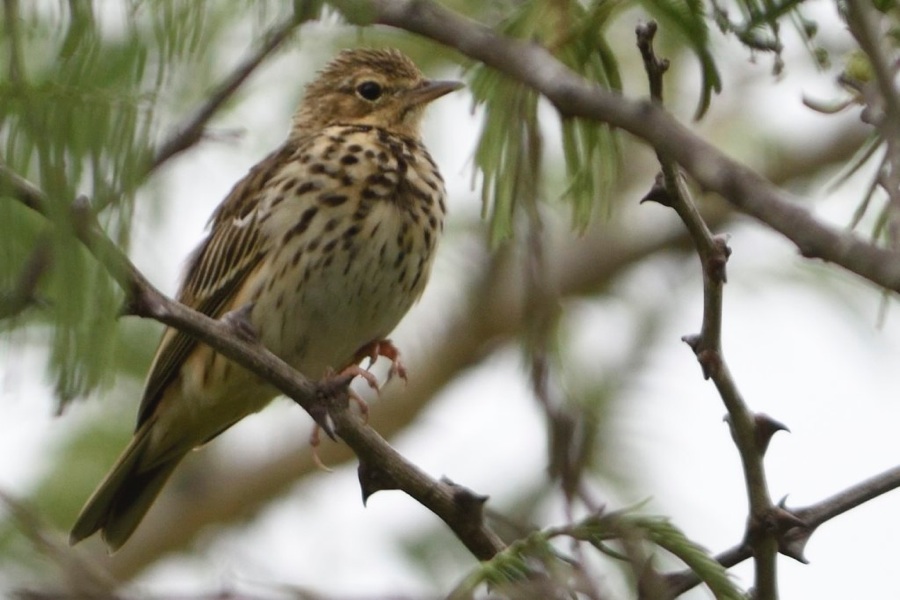
Tree Pipit, Anthus trivialis
Day 12, January 6, Iringa - Mikumi
Florence wanted to go back to Dave Moyer´s farm this morning. We left early and reached the farm. We met Dave´s wife that gave us permission to bird. The afternoon before, there were birds everywhere, but it was very quiet now. I saw a Spot-flanked Barbet, Male and female Klaas´s Cuckoo and a Orange-breasted Bush-Shrike, but that was it. Florence decided to go back to camp. On the way down, we saw a Lizard Buzzard feasting on a Chameleon. We got back to River Valley, packed and headed for Mikumi. We found a Steppe Buzzard on the wire. We drove on and I saw a raptor perched. I turned around and got very nice shot of a Grey Kestrel. Just a few km down the road a Long-crested Eagle was perched on another phone pole. We soon got closer to Mikumi. We would normally had stayed at Tan-Swiss in Mikumi, but I knew the owner of the brand new Tarangire Adventure Lodge, and he had given us a good rate to try it out. It turned out that the lodge were in a very nice Miombo Woodland and while waiting for lunch, Florence spotted some birds in the garden. I quickly saw that one of them was a Tit and sure enough a Cinnamon-breasted Tit. After lunch, we decided to check out a Miombo Woodland patch that Neil had told me about. The plan was to go there the morning after, but I just wanted to find it so we knew were to go in the morning. We found the patch and returned to camp in time for the afternoon birding. It was quite slow for a while before we had a bird party coming through the garden of the lodge. We had Golden-breasted Bunting, White-eyed Slaty and Spotted Flycatchers, Violet-backed Starling, Red-headed Weaver, Grey Penduline-Tit, Cinnamon-breasted Tit, Greater Blue-eared Starling and a noisy flock og White-crested Helmet-Shrikes before the darkness set in.
Some pictures from day 12 Iringa to Mikumi
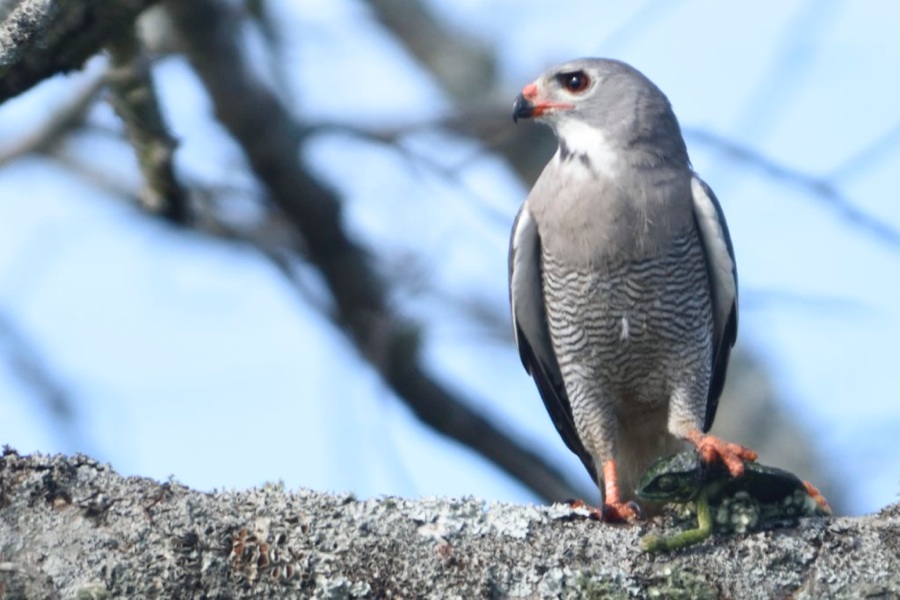
Lizard Buzzard, Kaupifalco monogrammicus
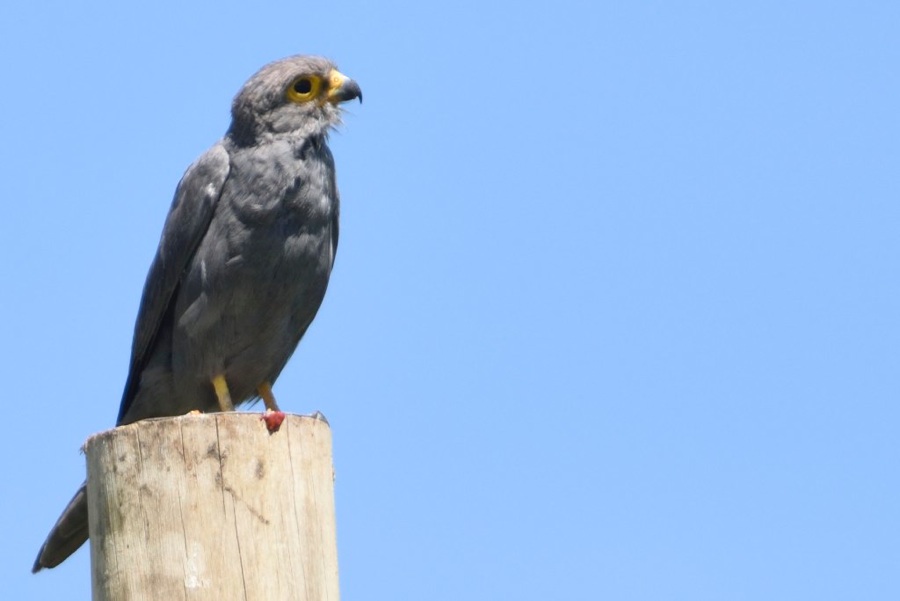
Grey Kestrel, Falco ardosiaceus
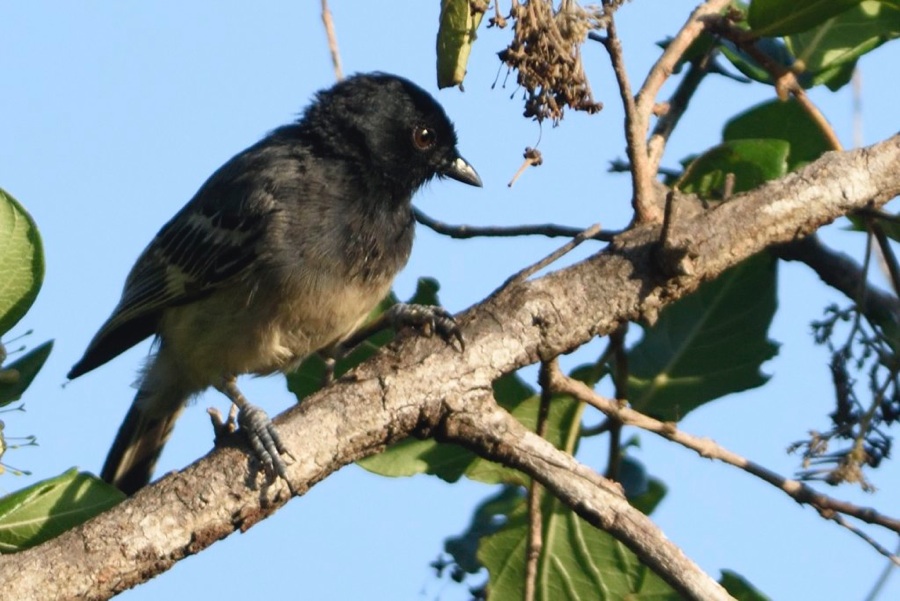
Cinnamon-breasted Tit, Parus pallidventris
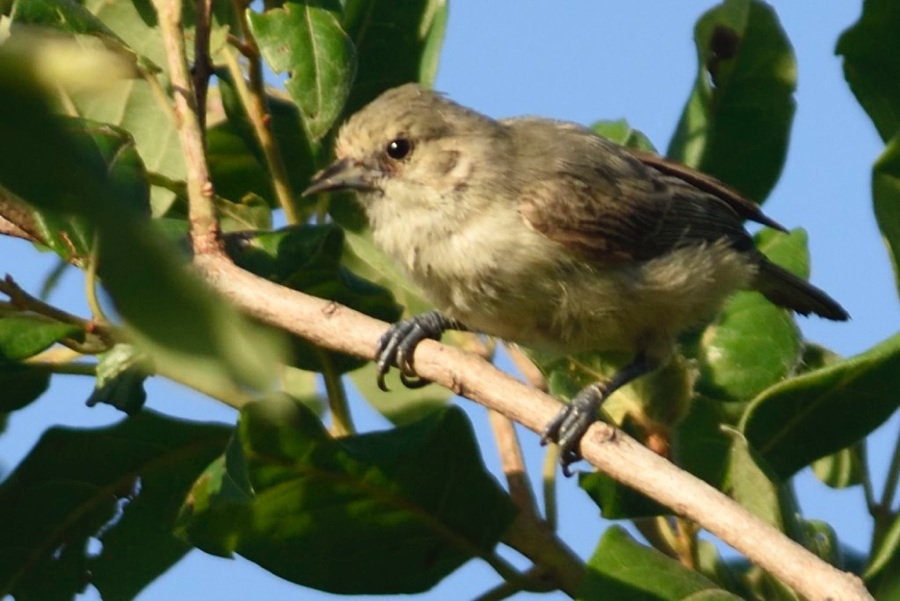
Grey Penduline-Tit, Anthoscopus caroli
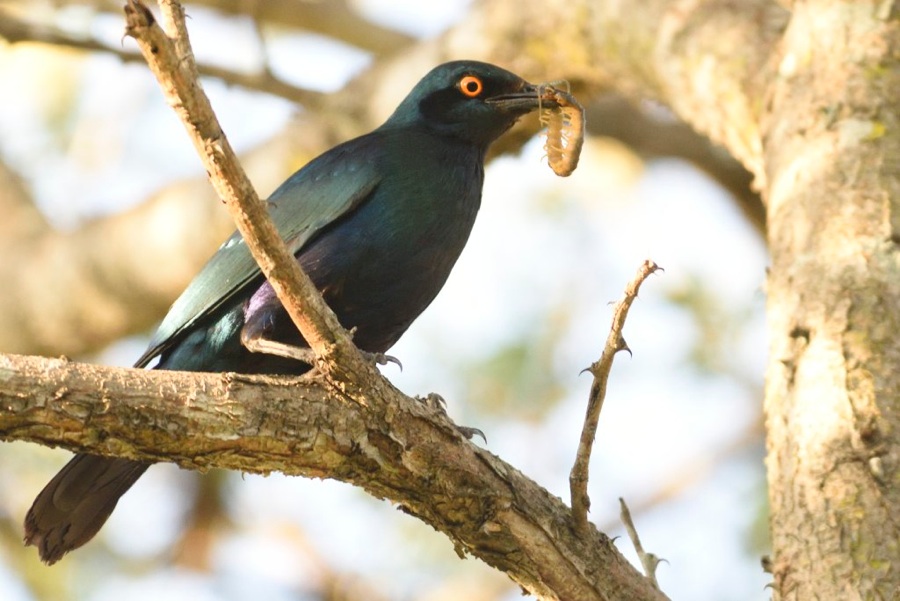
Greater Blue-eared Starling, Lamprotornis chalybaeus
Day 13, January 7, Mikumi
Florence and I went early towards the Miombo Woodland. The place is about 10 km from the main road. It is a a clearing were a pipeline runs. The first birds of interest were a pair of Arnot´s Chats. They perched nicely for us. The next bird we found was a lifer: Hoffmann´s Sunbird (recently split from Shelley´s Sunbird). The sunbird was quite common, but with bad light and the small birds in the canopy, it was very hard to get decent pictures. We spotted a Lizard Buzzard and a African Harrier-Hawk. We continued down the path and picked up Neddicky, Violet-backed Starling, White-winged Widowbird, Yellow Bishop, Kurrichane Thrush, Common Waxbill, Black Cuckooshrike and Yellow-fronted Canary. Then we had a flock of Pale-billed Hornbills (picture lifer) entertaining us. Florence decided to stay in the spot, but I went back to try to get better pictures of the Sunbird. This was not an easy task and I had to give up. I did pick up a Green-capped Eremomela though. I picked up the car and drove to fetch Florence. She was no where to be seen. I called for her and she did not reply. This is not very far from Mikumi National Park and no fences exist. My heart started beating a little faster. I went in to the woodland and called one more time. She finally replied. I walked towards her, but could not find her. I called again and she replied further away. For some strange reason she thought my voice was coming from the other side and she walked towards where she thought I was. I finally managed to stop her and I caught up with her. Very relieved, we walked back to the car. It was now getting hot and it was time to return to camp for lunch. After a few km, I heard the familiar sound of an exploded tire. I tried to jack up the car, but the jack was not high enough. Somehow I managed to place a piece of wood under the jack and managed to jack it up. Then I went to fetch the spare tire. It turned out that I could not loose the bolts of this tire. After hanging on the wrench, I finally managed to loosen two of the bolts, the third was completely stuck. We managed to stop some locals on a motor bike and together we managed to loosen the last bolt. I put the spare tire on and lowered the car only to find out that the spare tire was almost flat. We drove slowly back to Mikumi and lucky for us the first house we came to contained a tire repair shop. The original tire were beyond repair and they could not supply me with a new one. They pumped up the spare. I knew we were going into Mikumi National park this afternoon and did not like going there without a spare tire, but what do you do? We returned to camp and had lunch
Some pictures from day 13 in the Miombo Woodland outside Mikumi:
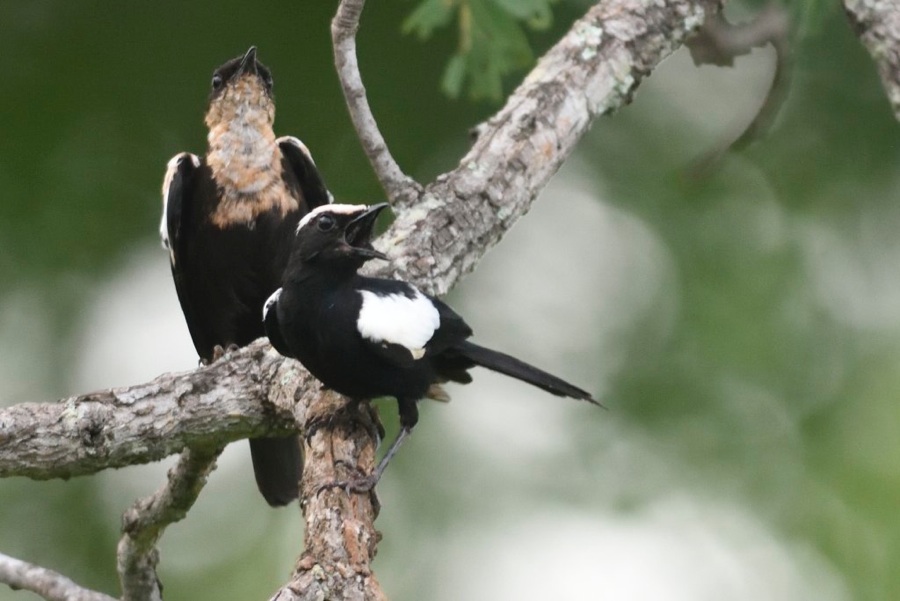
Arnot´s Chat, Pentholaea arnotti
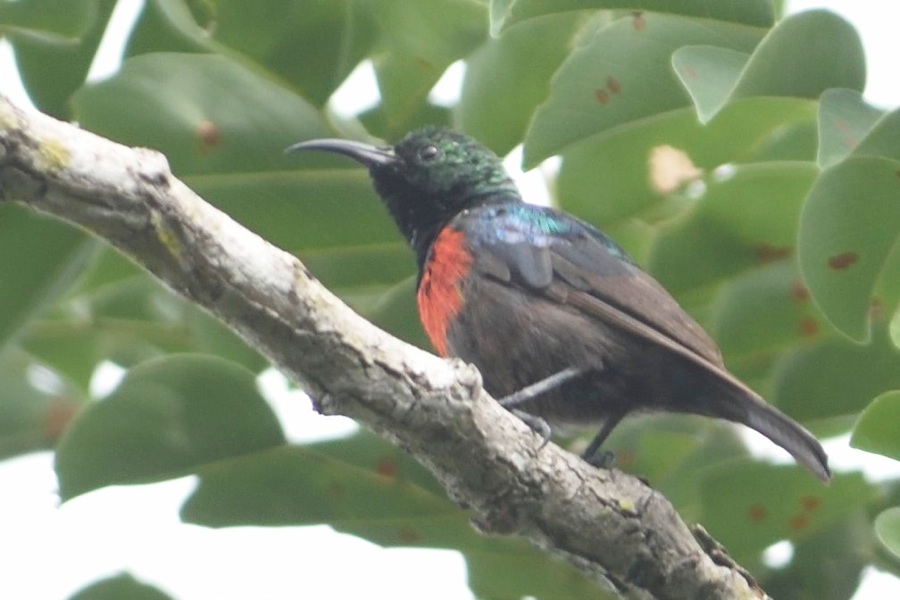
Hoffmann´s Sunbird, Cinnyris Hoffmani - Lifer
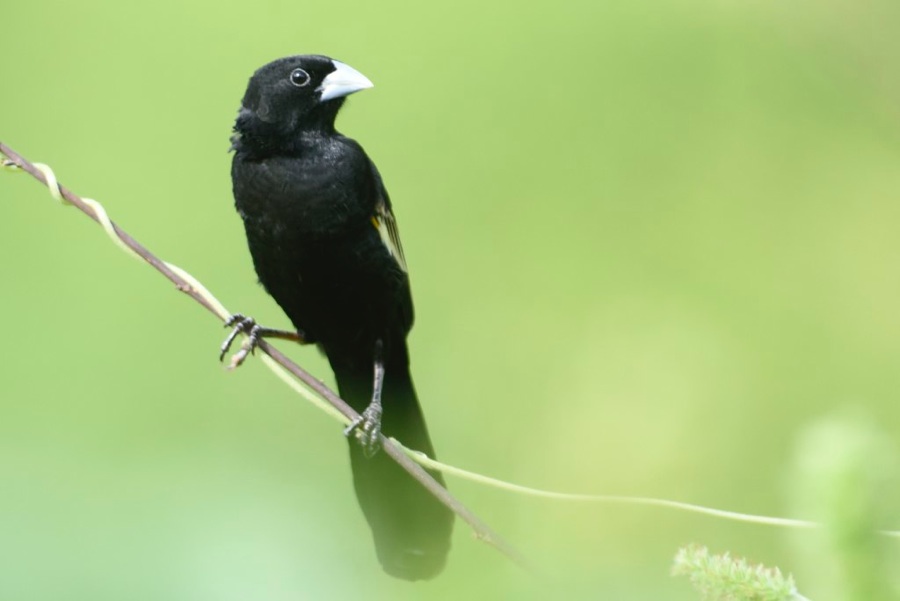
White-winged Widowbird, Euplectes albonatus
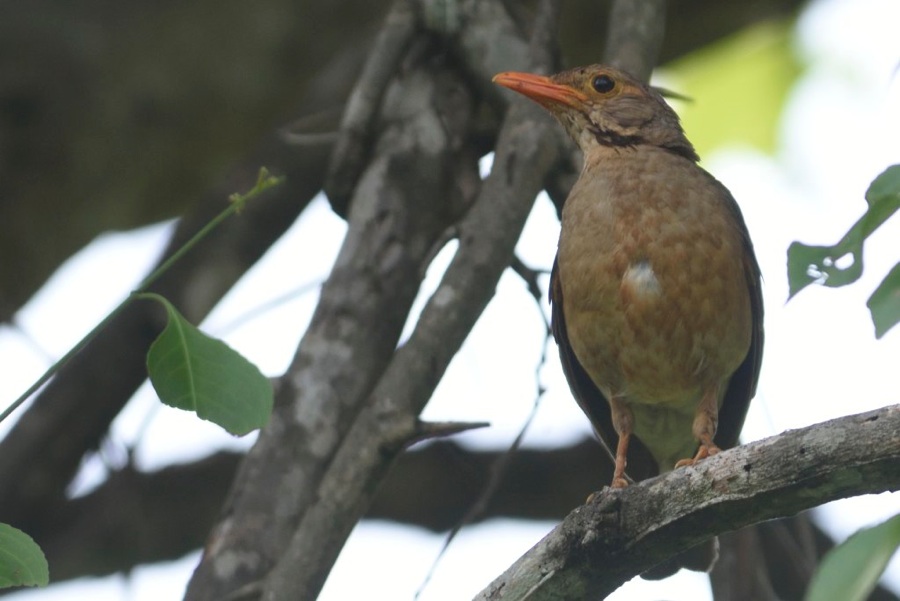
Kurrichane Thrush, Turdus libonyanus
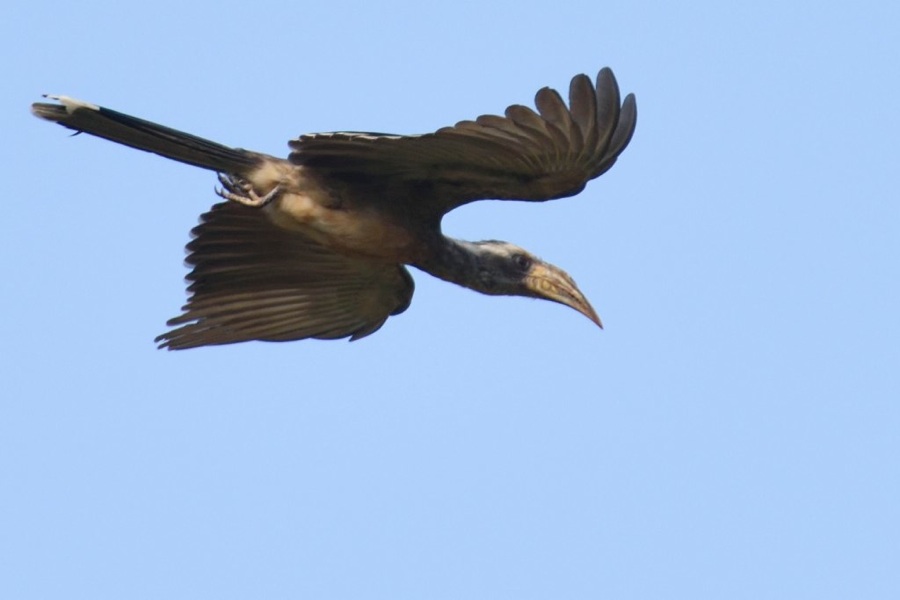
Pale-billed Hornbill, Tockus pallidirostris - Photo Lifer
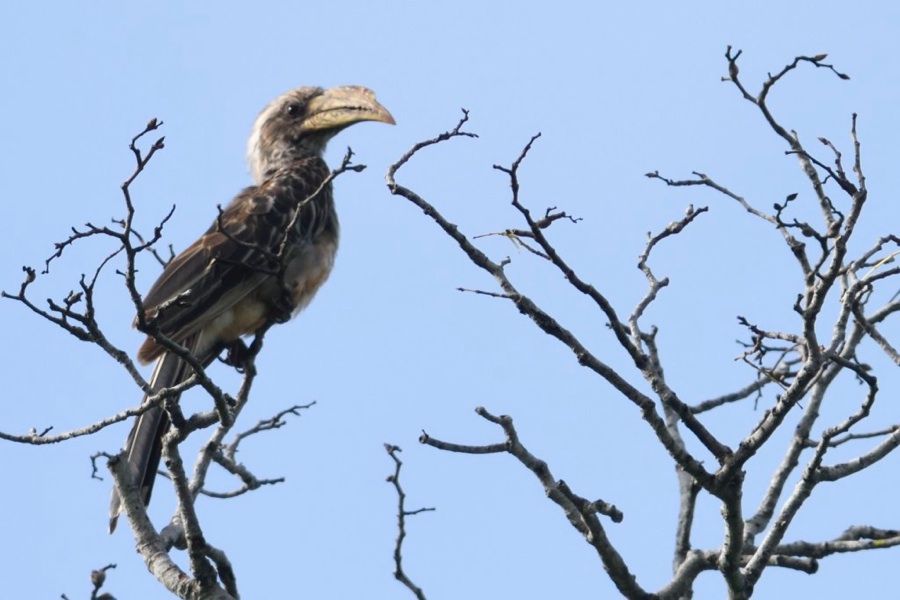
Pale-billed Hornbill, Tockus pallidirostris - Photo Lifer
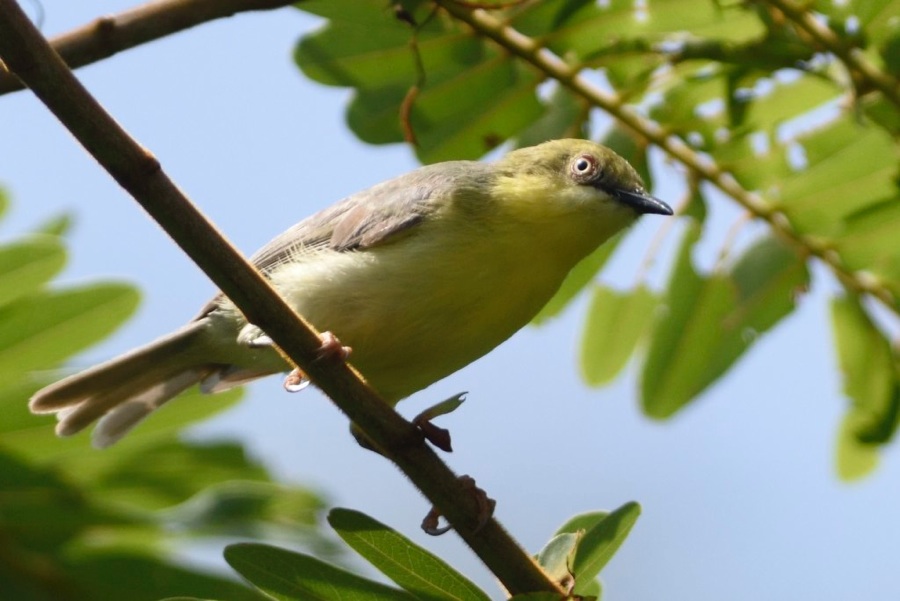
Green-capped Eremomela, Eremomela scotops
Day 13, January 7, Mikumi continued
After lunch, we drove to the park. I wanted to buy a 24 hour pass so we could go in in the afternoon and come back in the morning, but apparently the rules had changed. We had to buy tickets in the afternoon and once again the morning after. They did not even have a map to give us, but I had been there before and knew basically were to go. We drove in and headed for the Hippo pool. We saw a Yellow-breasted Longclaw. At the hippo pool we had more than 100 Collared pratincoles. It looked like most of them were juveniles. I got some pictures of a Common Sandpiper. We drove to the southern part of the park, we got nice pictures of a Green Wood-Hoopoe followed by the first family of Southern Ground-Hornbills. We drove on and found another family of Ground-Hornbills, before we found a nicely perched juvenile Red-backed Shrike. We were now driving north. We stopped at a dry waterhole and had nice views of a Black-bellied Bustard. I felt the birds this time as well was few and far apart. We drove all the way up to the picnic site before we found the third family group of Ground-Hornbills. A little further at another dry waterhole, we had a pair of Saddle-billed Storks. We got some good pictures of them before we moved even further north. We drove all the way up to Mwaranbwogo without seeing anything special. I was then desperate and took a picture of a Long-tailed Shrike. We started driving back. I managed to flush a Pallid Harrier from the road. One more were still on the road, but I struggled to focus the camera and it took off. A little further we picked up 4 individual Black-bellied Bustard (three males and one female). Then a flock of Yellow-billed Oxpeckers on some Giraffes. Further on a perched European Hobby and a little further still another European Hobby. We were now getting close to the gate and closing time, but managed pictures of a Red-necked Francolin feeding on Elephant dung. We were at the gate exactly at closing time and went back to camp for dinner. After dinner I had quite a few beers and some serious words with Sam, the guy that owns the lodge and also the company we always rent our cars from (Sam´s Car Rental).
Some pictures from day 13 Mikumi National Park:
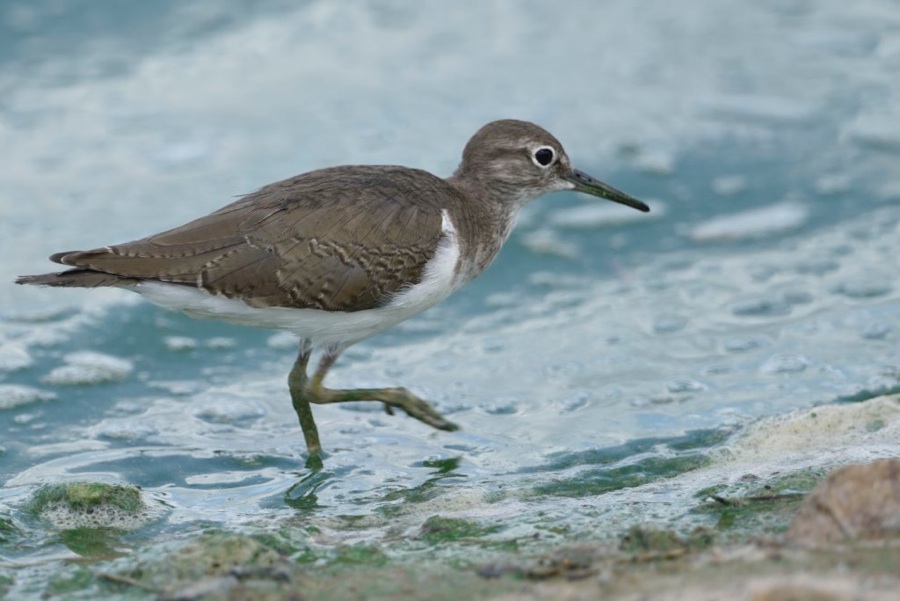
Common Sandpiper, Actitis hypoleucos
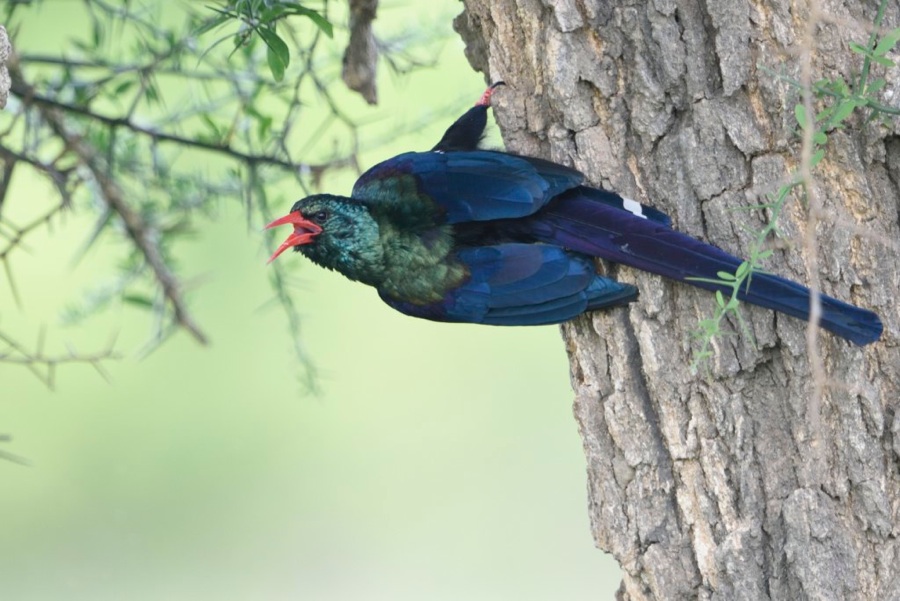
Green Wood-Hoopoe, Phoeniculus purpureus
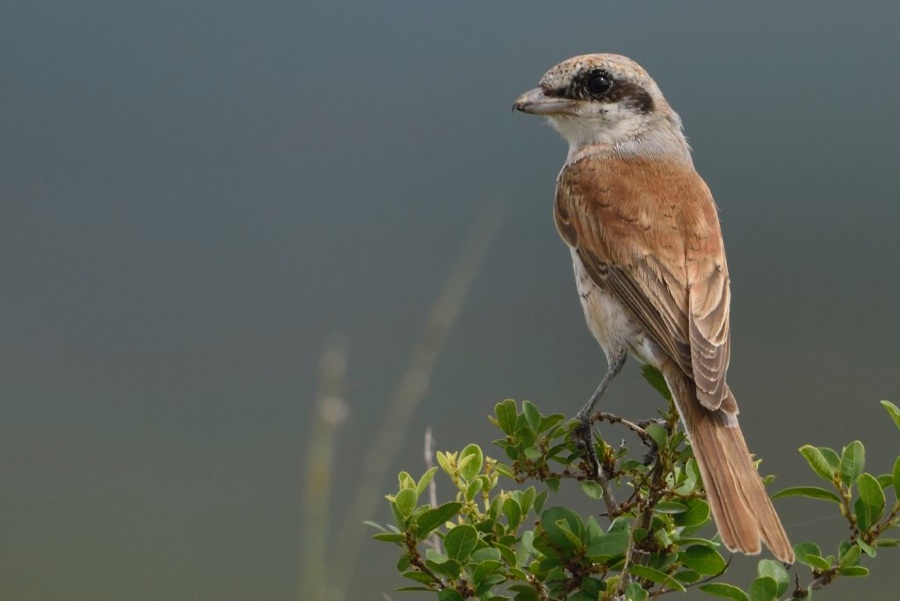
Red-backed Shrike juvenile, Lanius collurio
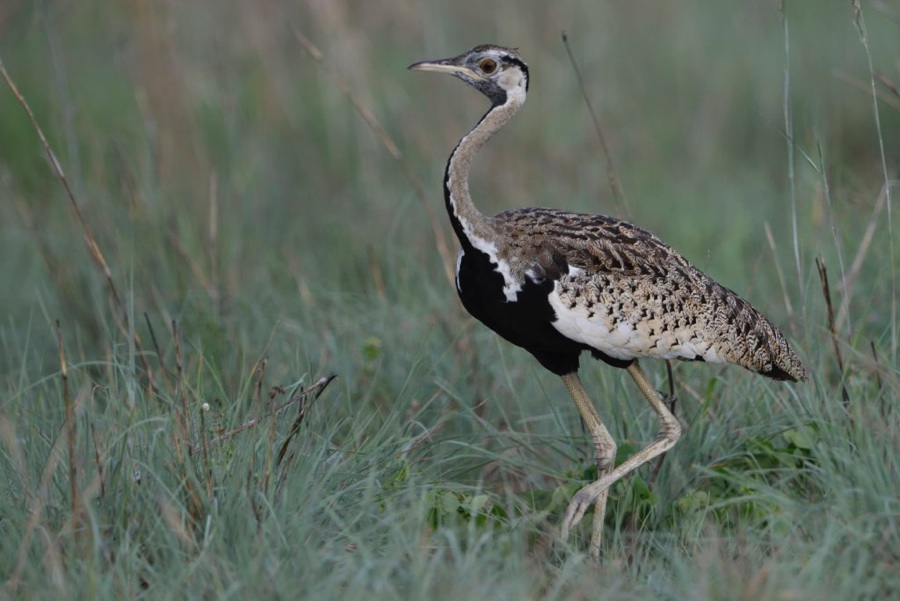
Black-bellied Bustard, Lissotis melanogaster
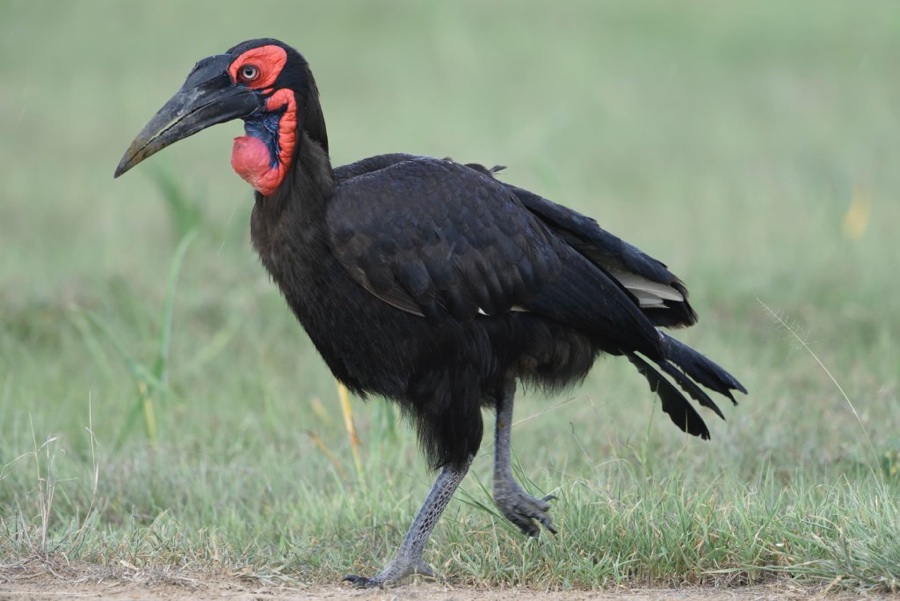
Southern Ground-Hornbill, Bucorvus leadbeateri
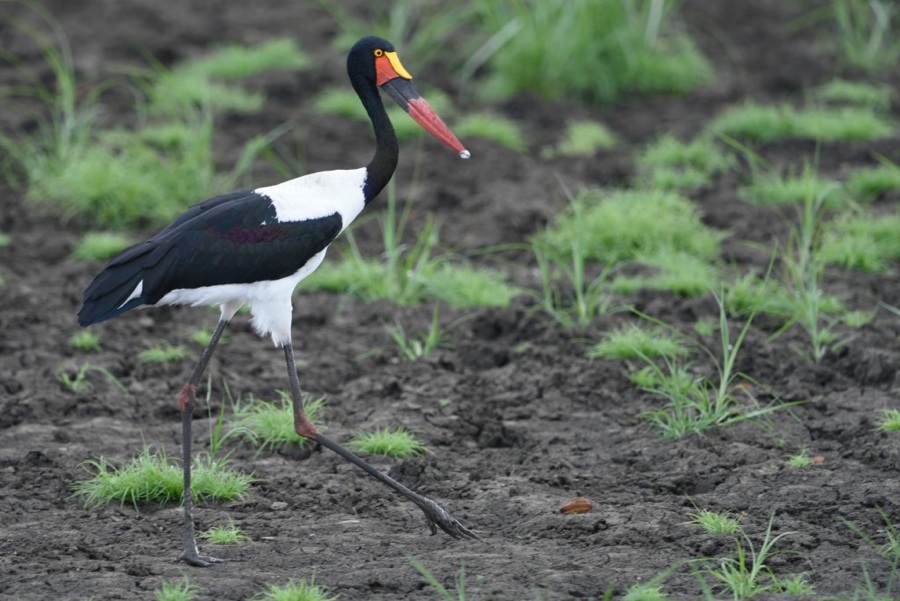
Saddle-billed Stork female, Ephippiorhynchus senegalensis
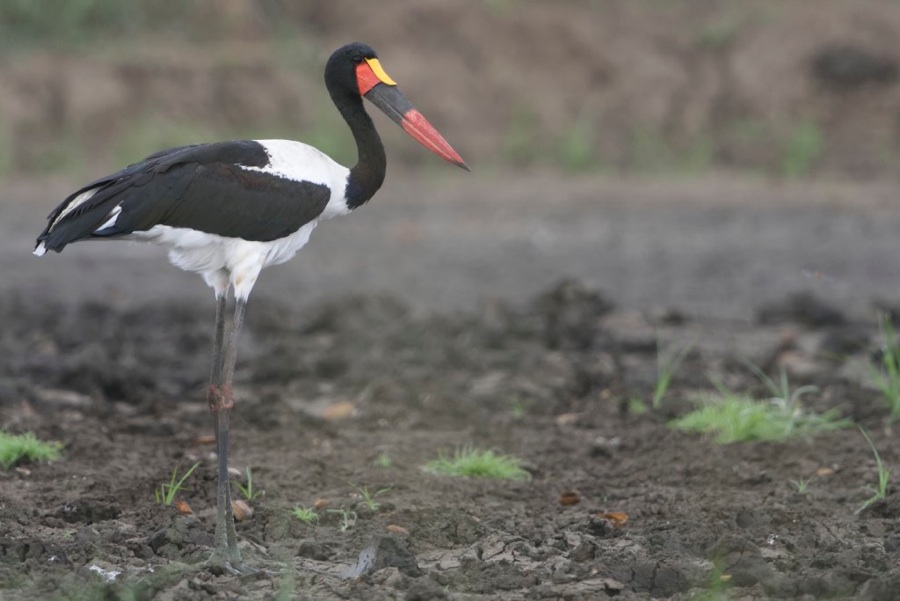
Saddle-billed Stork male, Ephippiorhynchus senegalensis
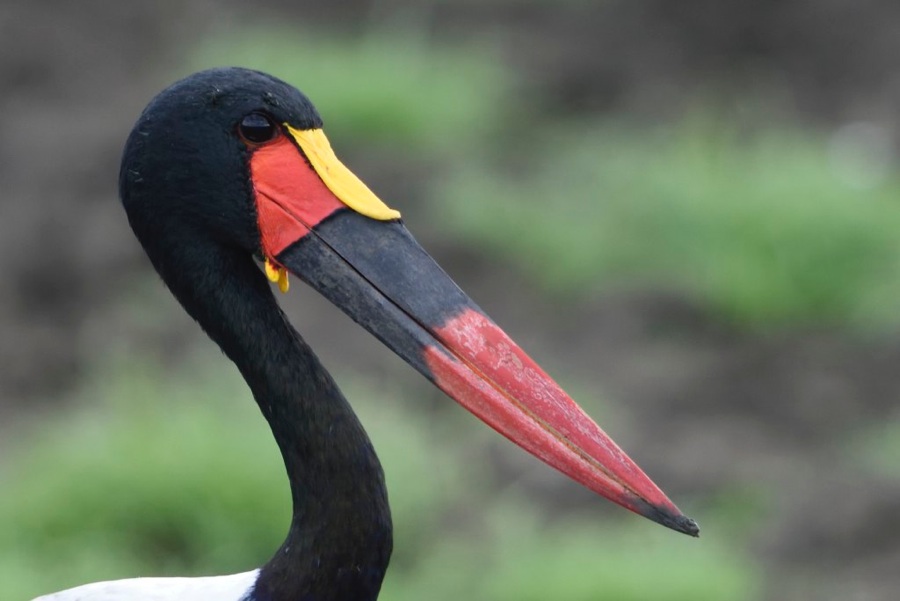
Saddle-billed Stork male portrait, Ephippiorhynchus senegalensis
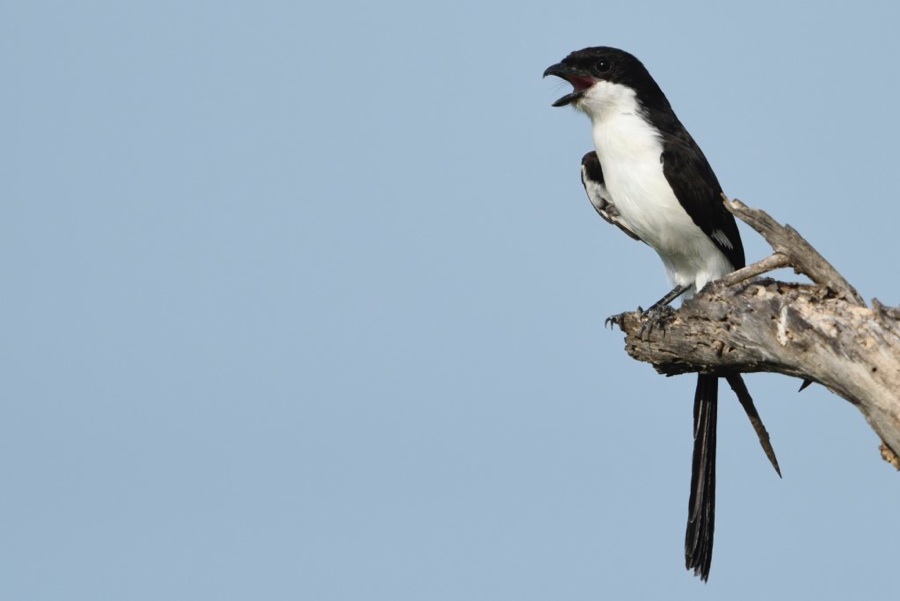
Long-tailed Fiscal, Lanius cabanisi
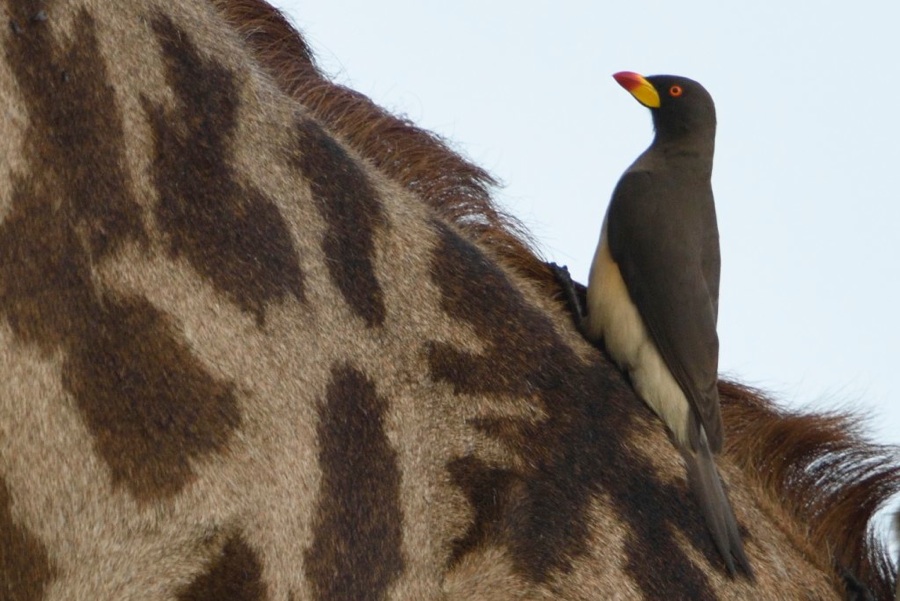
Yellow-billed Oxpecker, Buphagus africanus
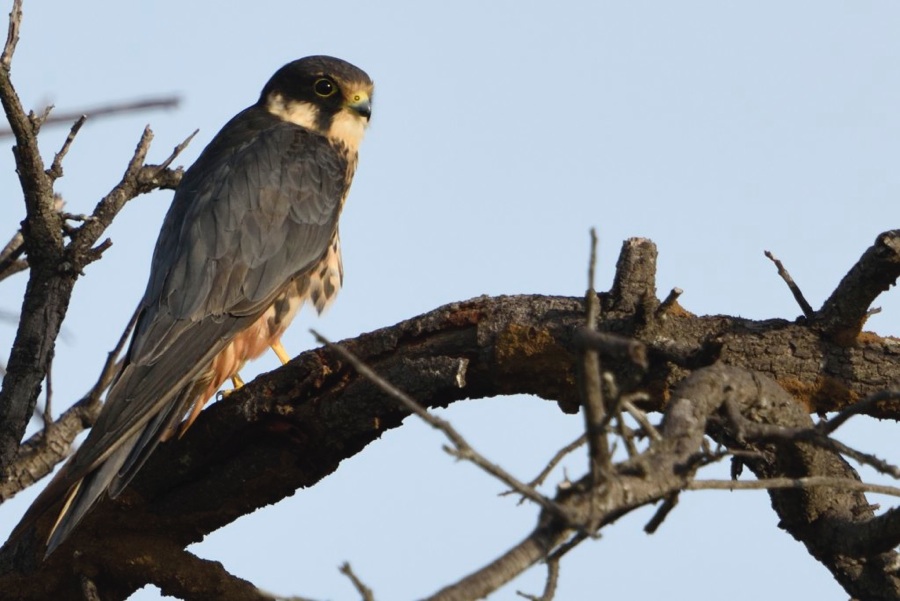
Eurasian Hobby, Falco subbuteo
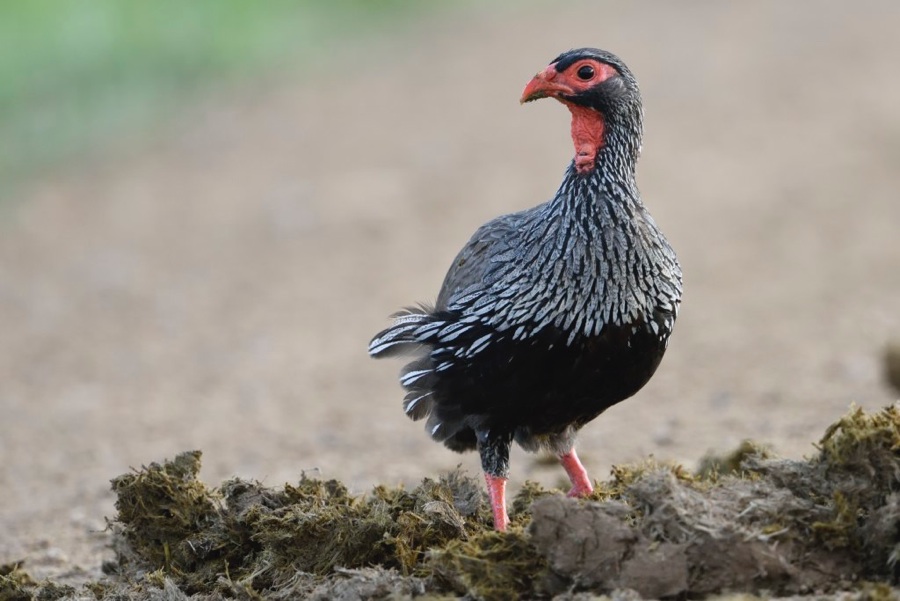
Red-necked Spurfowl, Pternistis afer
Day 14, January 8, Mikumi - Dar es Salaam
It was unfortunately time again to drive back to Dar es Salaam. However; we were going to spend the morning in Mikumi National Park before we started our journey back. We were at the gate at opening time, but no one was there to sell us any tickets. After 15 minutes of waiting, the people finally showed up. We drove more or less the same route this day as the day before. We found a pair of Black Coucals, but they were too far from the road to get nice pictures. We drove on and found quite a few Cisticolas: Croaking, Winding and Desert. At one point we saw a Gabar Goshawk chase and catch a Cisticola Sp. The Goshawk flew to a tree to eat, but we came to close and flushed it. We found a Grey Kestrel, but had better pictures from before. Yellow-throated Longclaw and then at the picnic site we followed a Pale Harrier for a long time. It landed and we tried to get some pictures. Florence was on the wrong side of the car. She went out and did not have patient to wait until I moved the car, so out in the open she flushed the bird. It was very quiet, the last bird we got was a European Roller. We were out of the park around 11:00 and headed straight for Dar es Salaam.
Some pictures from day 14 Mikumi National Park:
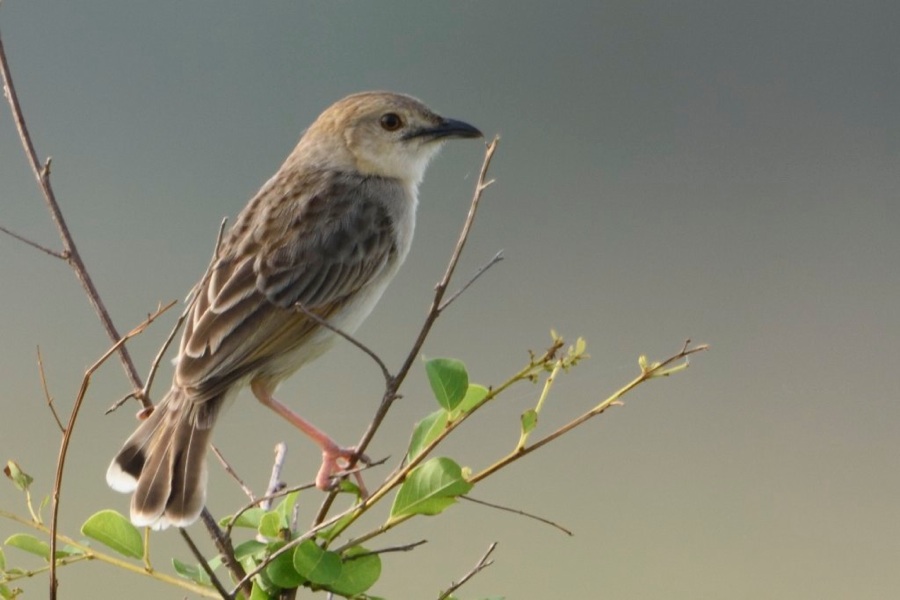
Croaking Cisticola, Cisticola natalensis
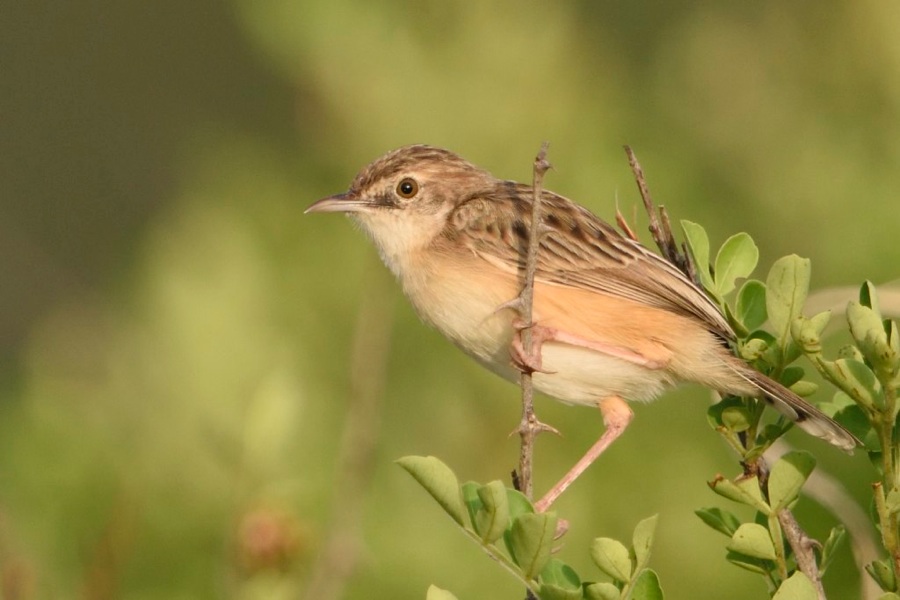
Desert Cisticola, Cisticola aridulus
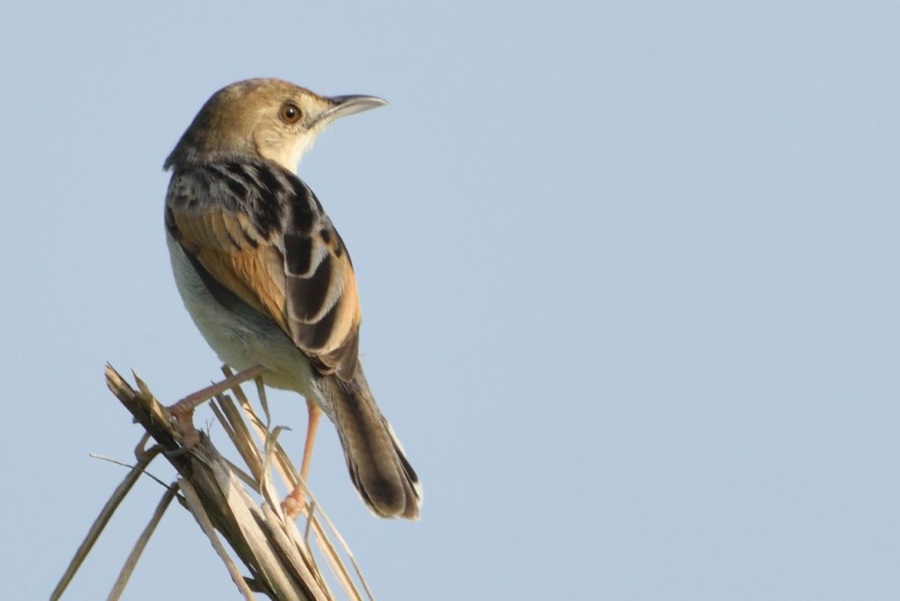
Winding Cisticola, Cisticola marginatus
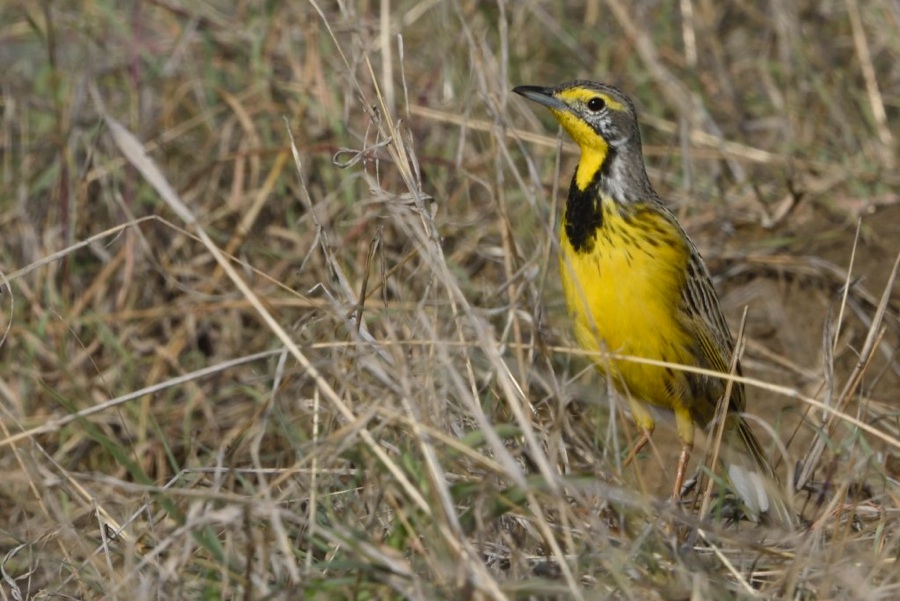
Yellow-throated Longclaw, Macronyx croceus
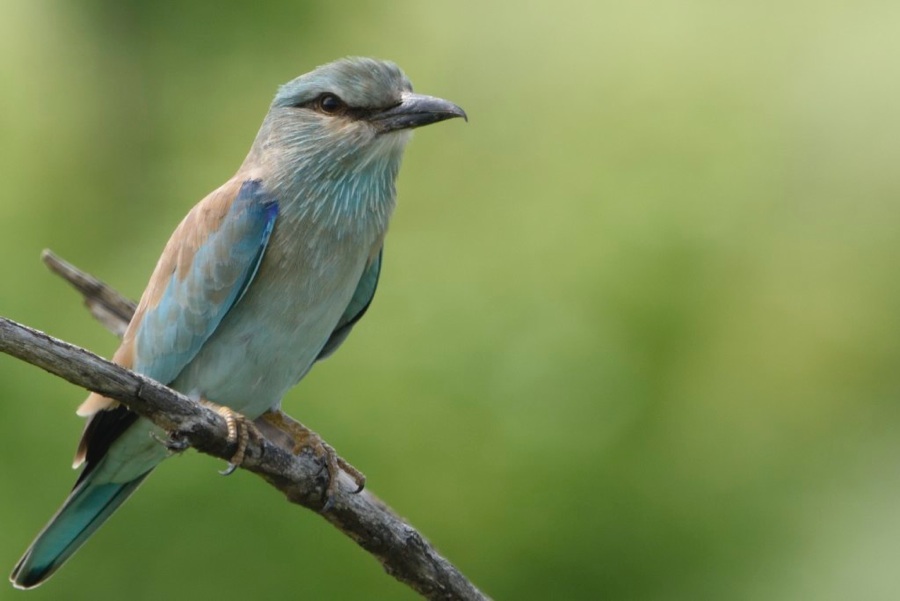
European Roller, Coracias garrulus
Day 15, January 9, Jangwani Salt Pans Dar es Salaam
I had made an appointment with Riaan Marais to take me to the Jangwani Salt Pans this day. Neil and Riaan had found a pair of Broad-billed Sandpipers on the pans a few weeks earlier. We went to the pans were they had seen the birds, but not many birds there. Riaan knew about another set of pans and arriving there we actually found too many birds. We were scanning and scanning through hundreds of birds, but it proved very hard to find the odd one out. We had the usual suspects of waders: Curlew Sandpiper, Marsh Sandpiper, Little Stints, Kittlitz Plover, Wood Sandpiper and Grey Plover. We had Yellow-billed Storks, Water Thick-knees, Dimorphic Egret, Zanzibar Red Bishop and Blue-cheeked Bee-eater. The latter and Marsh Sandpiper were actually new Tanzanian birds for me.
One picture from day 15 taken at Jangwani Salt pans:
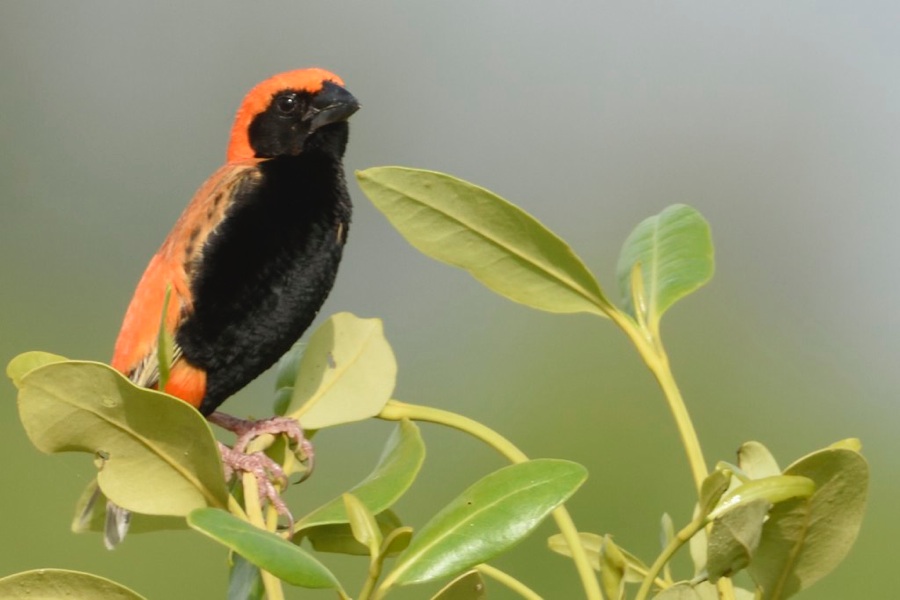
Zanzibar Red Bishop, Euplectes nigroventris
Day 16, January 10, Jangwani Salt Pans Dar es Salaam
Riaan came to pick me up at 05:00 this morning we picked up Friedemann Vetter on the way. We drove to Bagamoyo where we met up with Neil at the Livingstone Lodge. We saw Violet-backed Starling, Southern Black Flycatcher and heard a Black-crowned Tchagra on the way to the pans. Once at the pans, the first bird that Neil spotted was a Pacific Golden Plover. I could not resist taking a picture of a Black-winged Stilt :-). Moving on we saw a flock of European Curlews. I then spotted another Pacific Golden Plover. We had plenty of Lesser and Greater Sand Plovers. We spotted a single Lesser black-backed Gull and Neil counted more than 100 Caspian Terns. On the way pack, we had a nicely perched Coastal Cisticola. The pylons were full of Blue-cheeked- and Northern Carmine Bee-eaters. I took some pictures of the Bee-eaters while the others went a head. When I caught up with them, Riaan and Neil were kneeling and very busy taking pictures. My heart started bumping thinking they had found the Broad-billed Sandpipers. No such luck, they were taking pictures of a Curlew Sandpiper in nearly perfect breeding plumage. We went back to Livingstone Lodge and had breakfast. After breakfast Neil and Riaan took me to another spot in search of the Ruvu Weaver. At the first place we stopped, we did not see the Weaver, but got pictures of an African Openbill feeding on a snail. We also heard a Great Reed Warbler, but could not entice it to show itself. At the next stop we found the Ruvu Weaver (Lifer) right away. We stayed with the Weaver for a while trying to get some shots. A Diederick´s Cuckoo showed interest in the nest and the Weaver got very aggressive.
Some pictures from day 16 taken at Bagamoyo salt pans and surrounds:
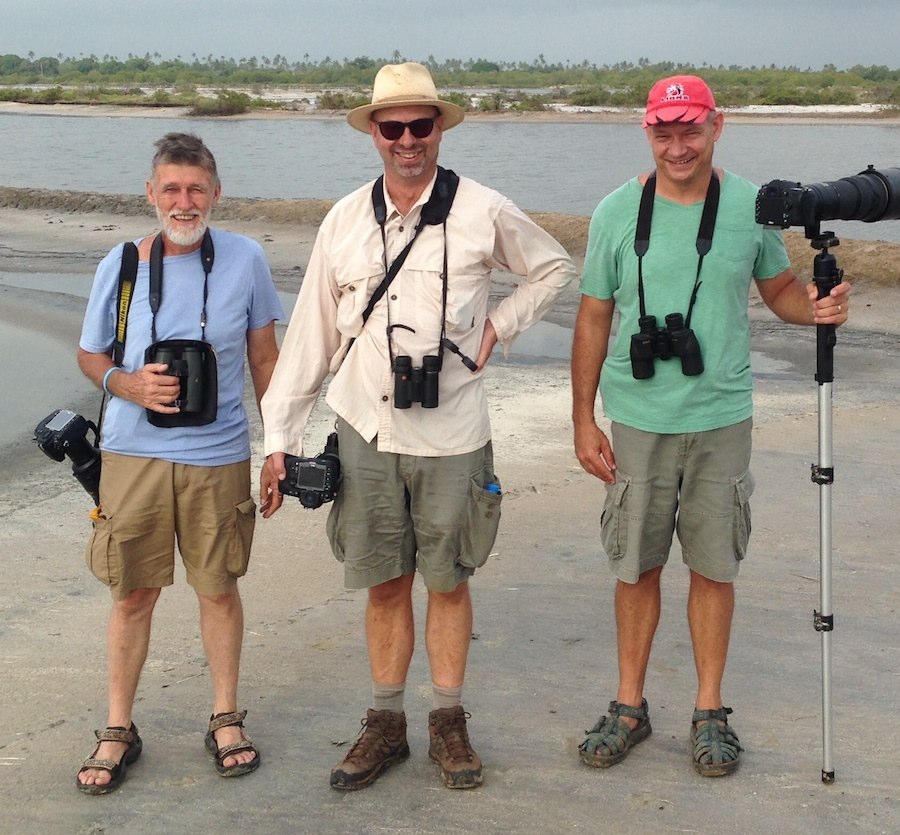
The Crazy gang: Neil, Per and Riaan at Bagamoyo Salt Pans
Pacific Golden Plover, Pluvialis fulva
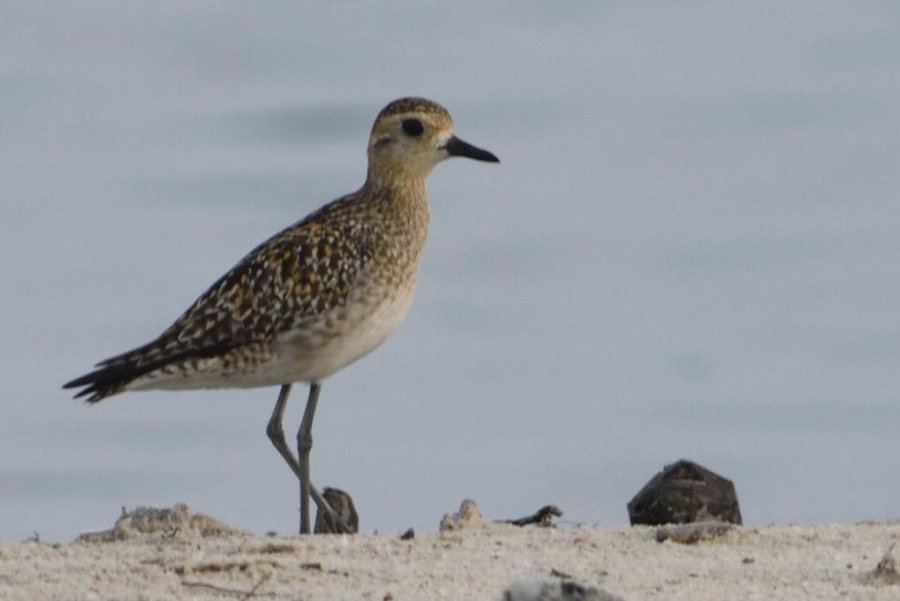
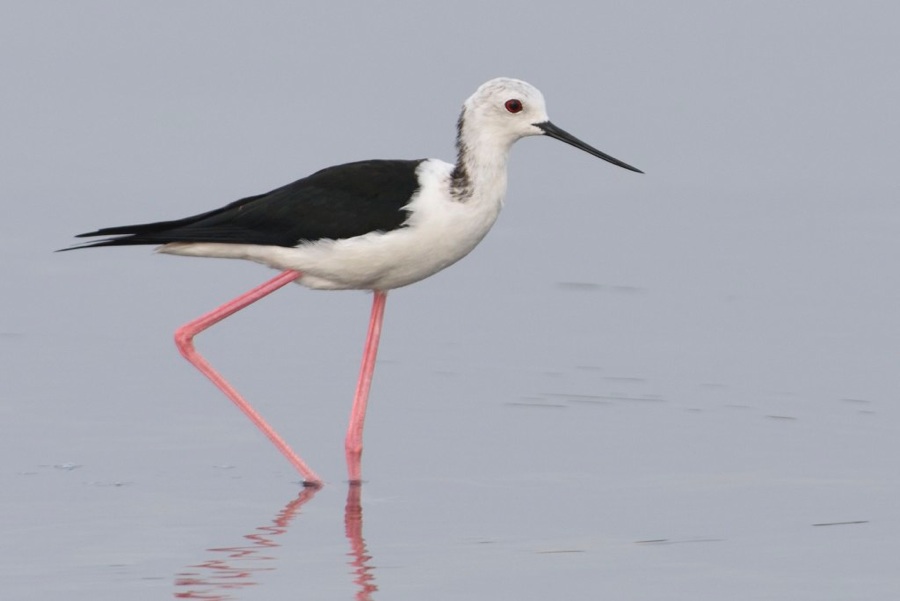
Black-winged Stilt, Himantopus himantopus
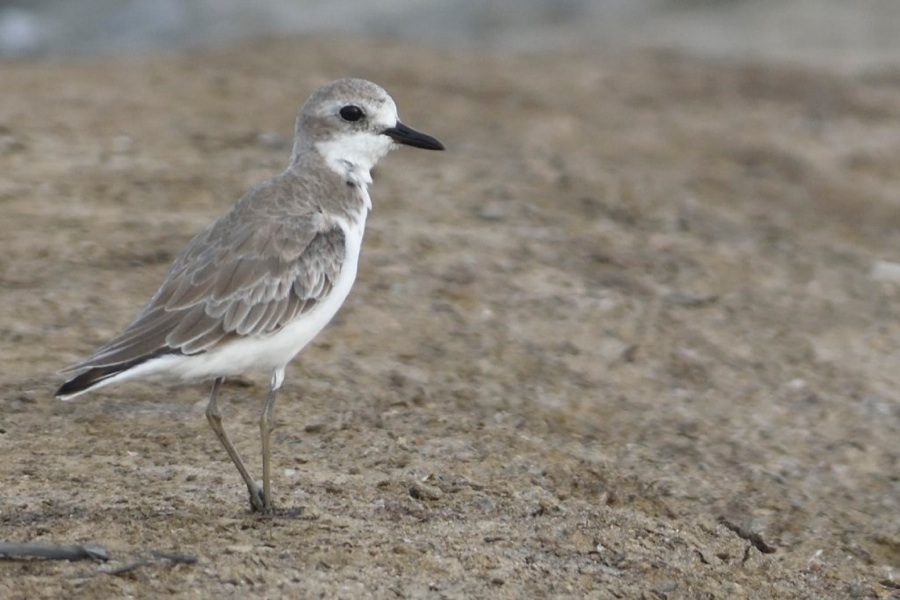
Greater Sand Plover, Charadrius leschenaultii
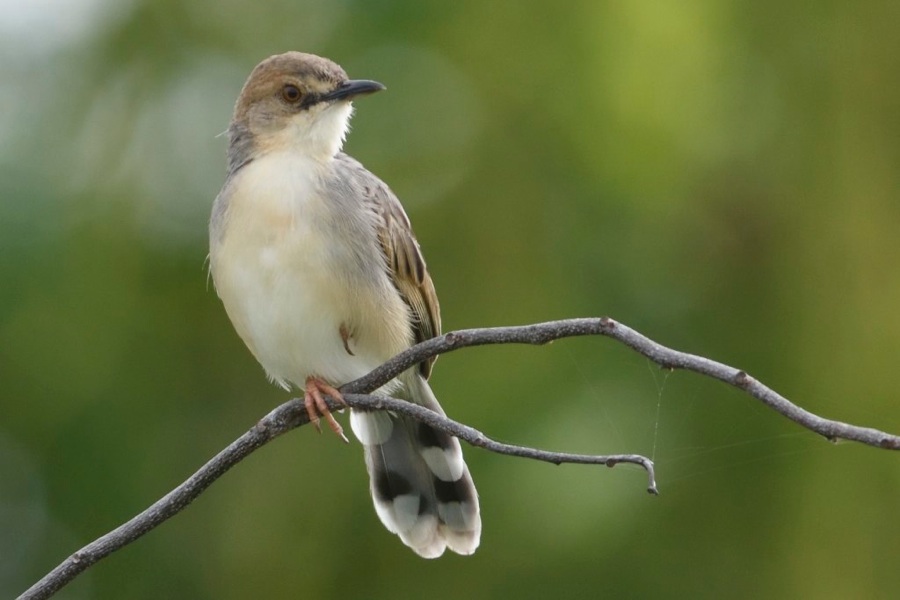
Coastal Cisticola, Cisticola haematocephala
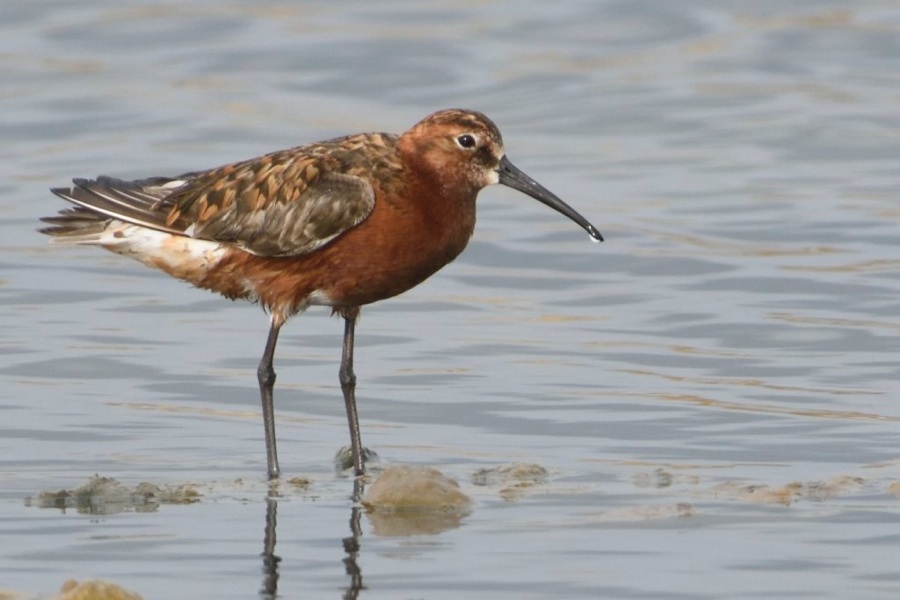
Curlew Sandpiper, Calidris ferruginea
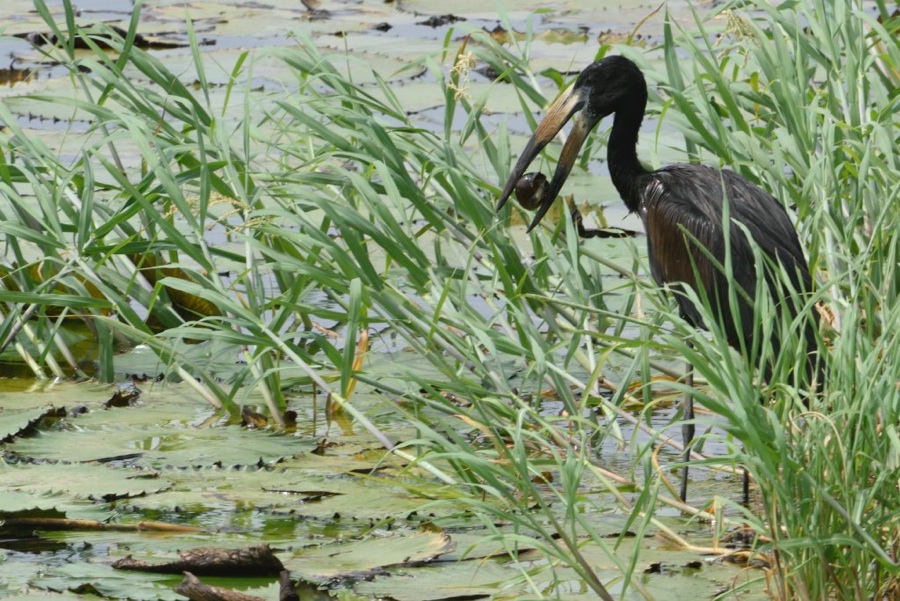
African Openbill, Anastomus lamelligerus
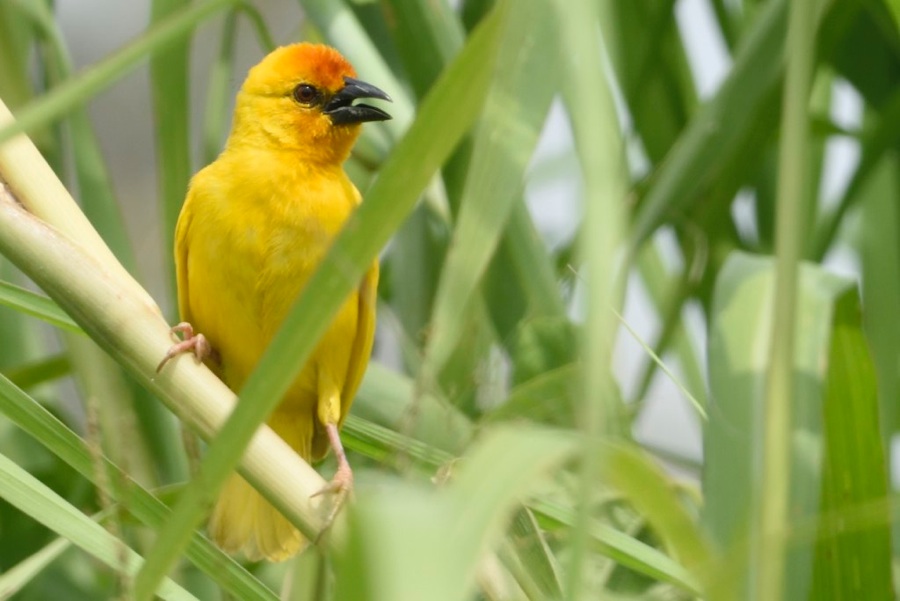
Ruvu Weaver, Ploceus holoxanthus - Lifer
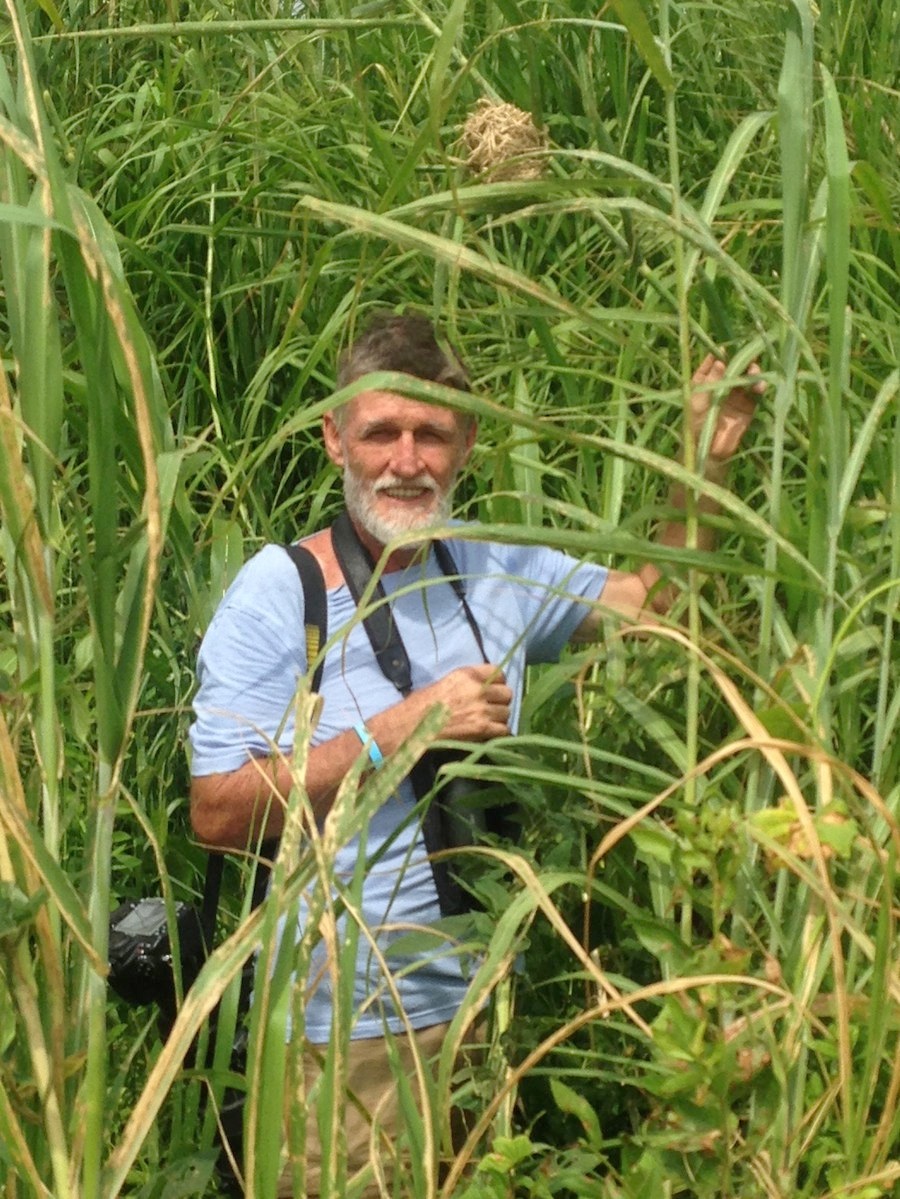
Neil Checking out the Ruvu Weaver nest.
Summing it all up.
We left Dar es Salaam on Tuesday January 12th to arrive in -15C in Norway on January 13th. Before we left, I met up with Neil again at Slipway on the 12th. We had some beers and a lot of fun. Before we left on the 12th, Riaan caught up with me at the hotel and we had a few sending off beers. I deposited my 600mm and a couple of Camera houses (D800 and D7000) with Neil and Riaan. I hope they make good use of them until we come back. It was really nice to finally meet up with both Neil and Riaan. We are already busy planning our next trip.
We saw roughly 250 bird species on our trip. Photographed around 150 species. I got 22 lifers and 2 picture lifers. I have now seen 586 species in Tanzania and have pictures of 533 different birds. I just made a new list and found out that I have a potential of 355 additional lifers in Tanzania, so a lot of work ahead :-)
Pinto´s Double-collared Sunbird, Cinnyris pintoi - Lifer
